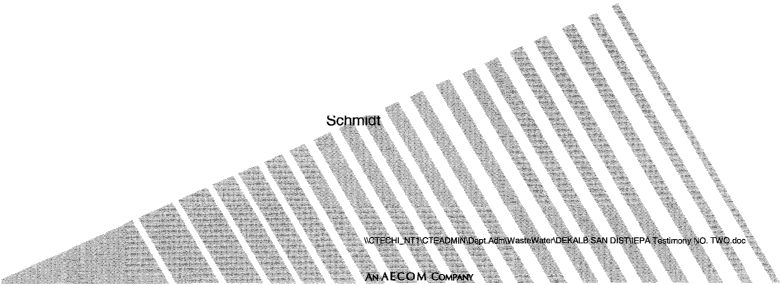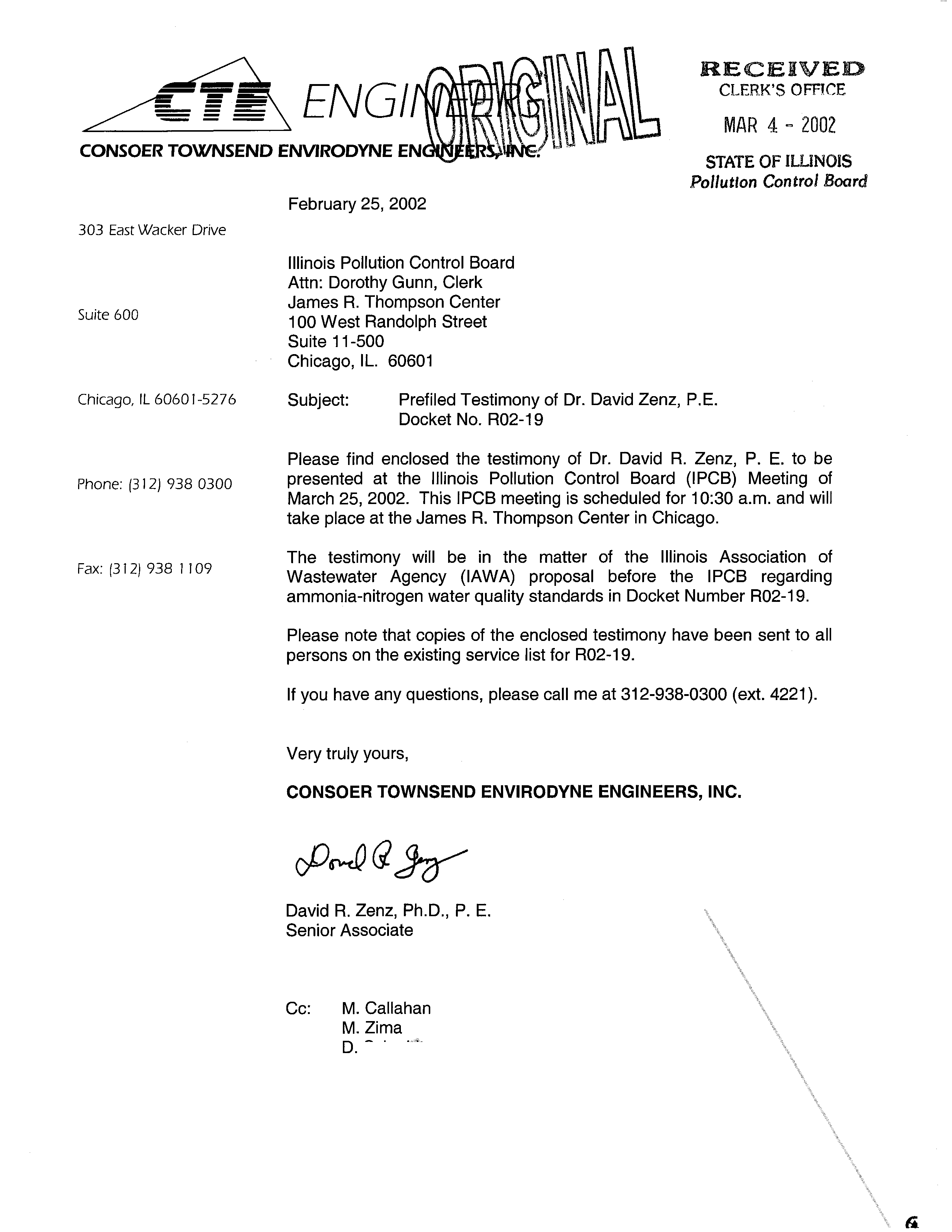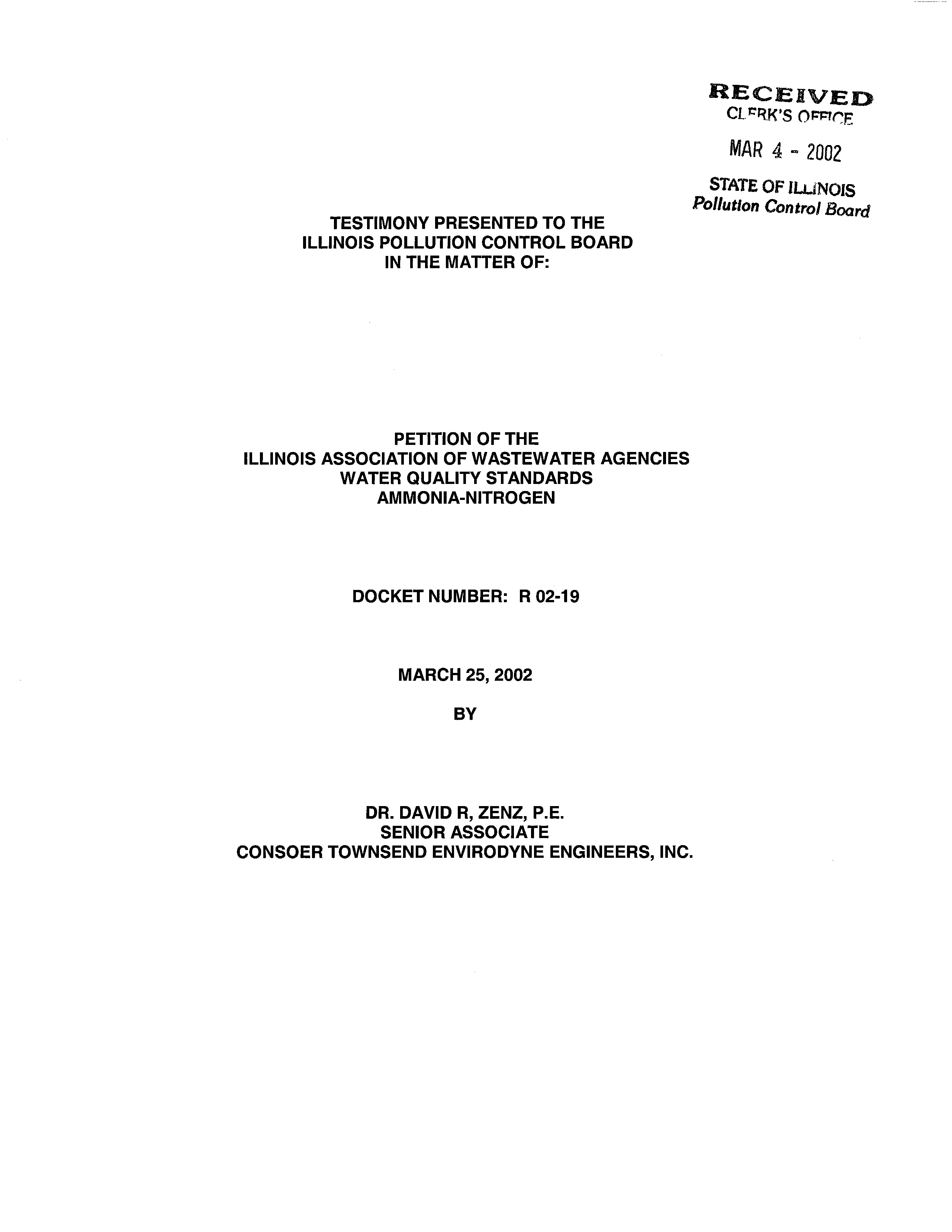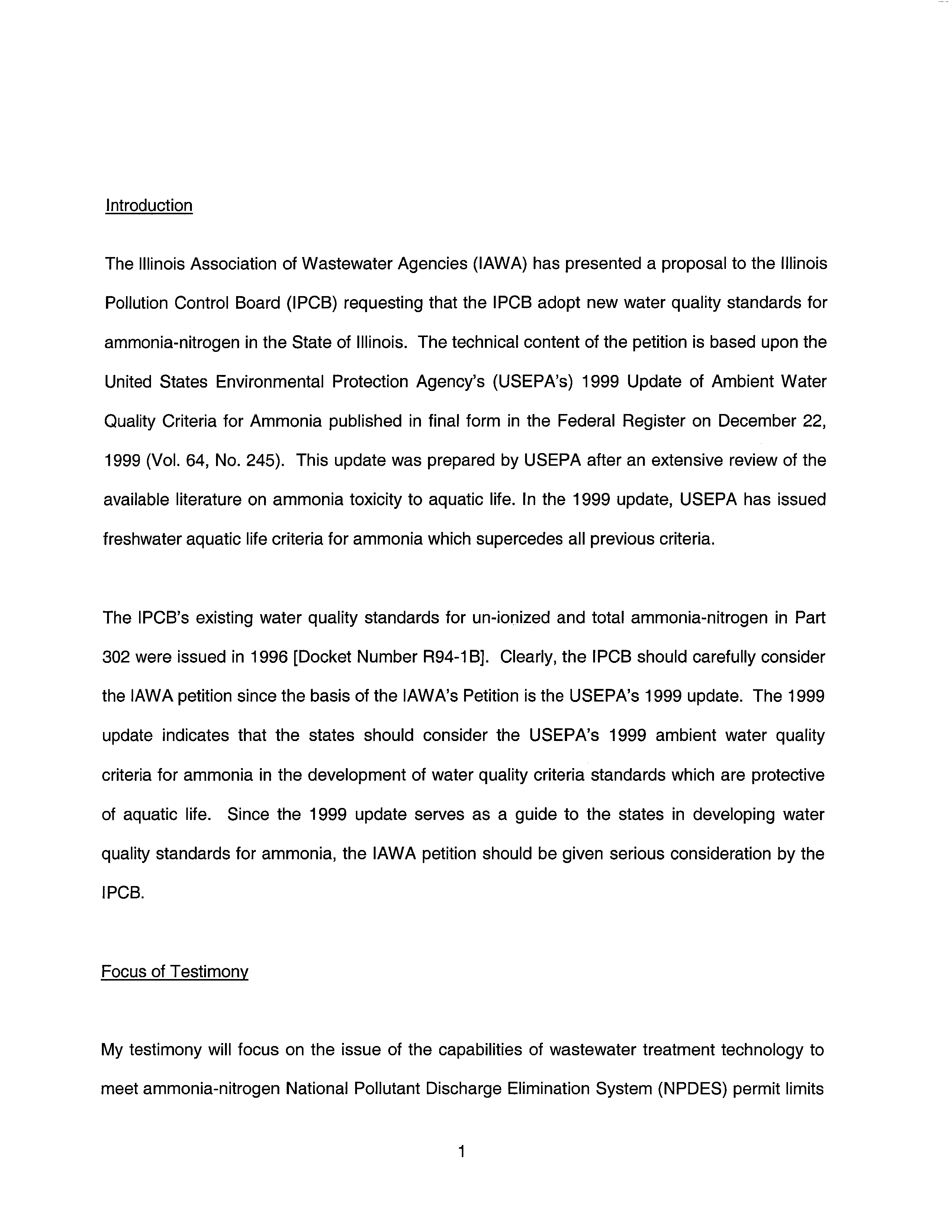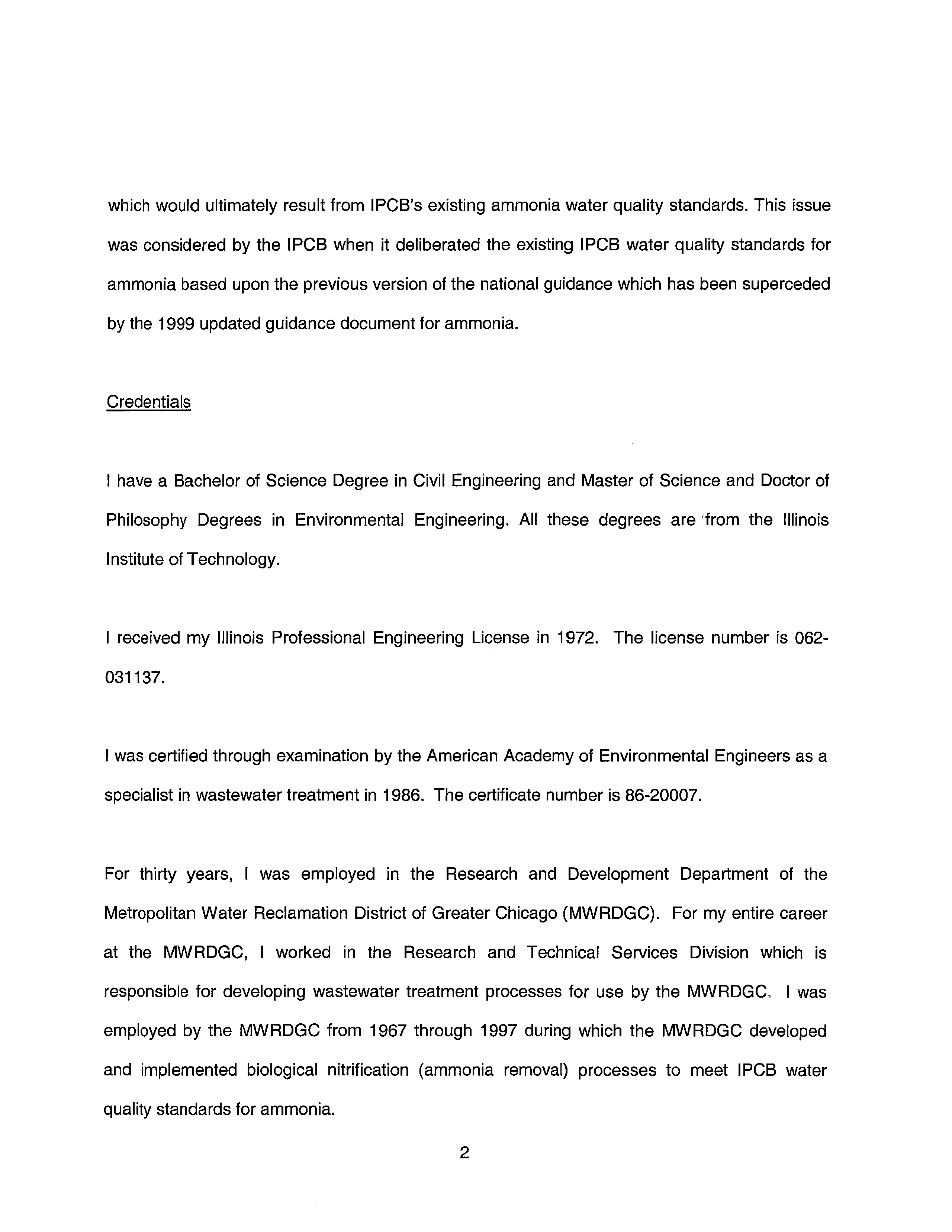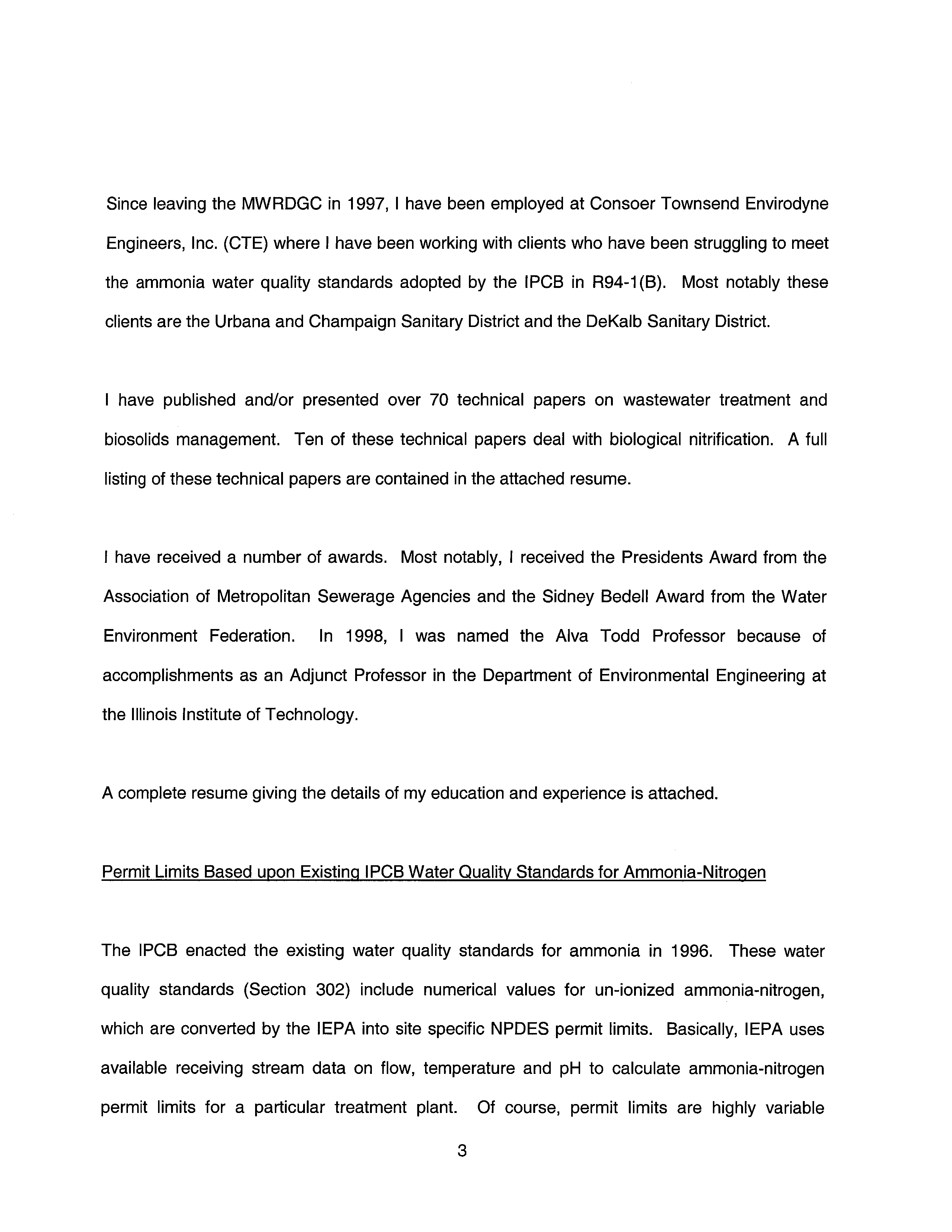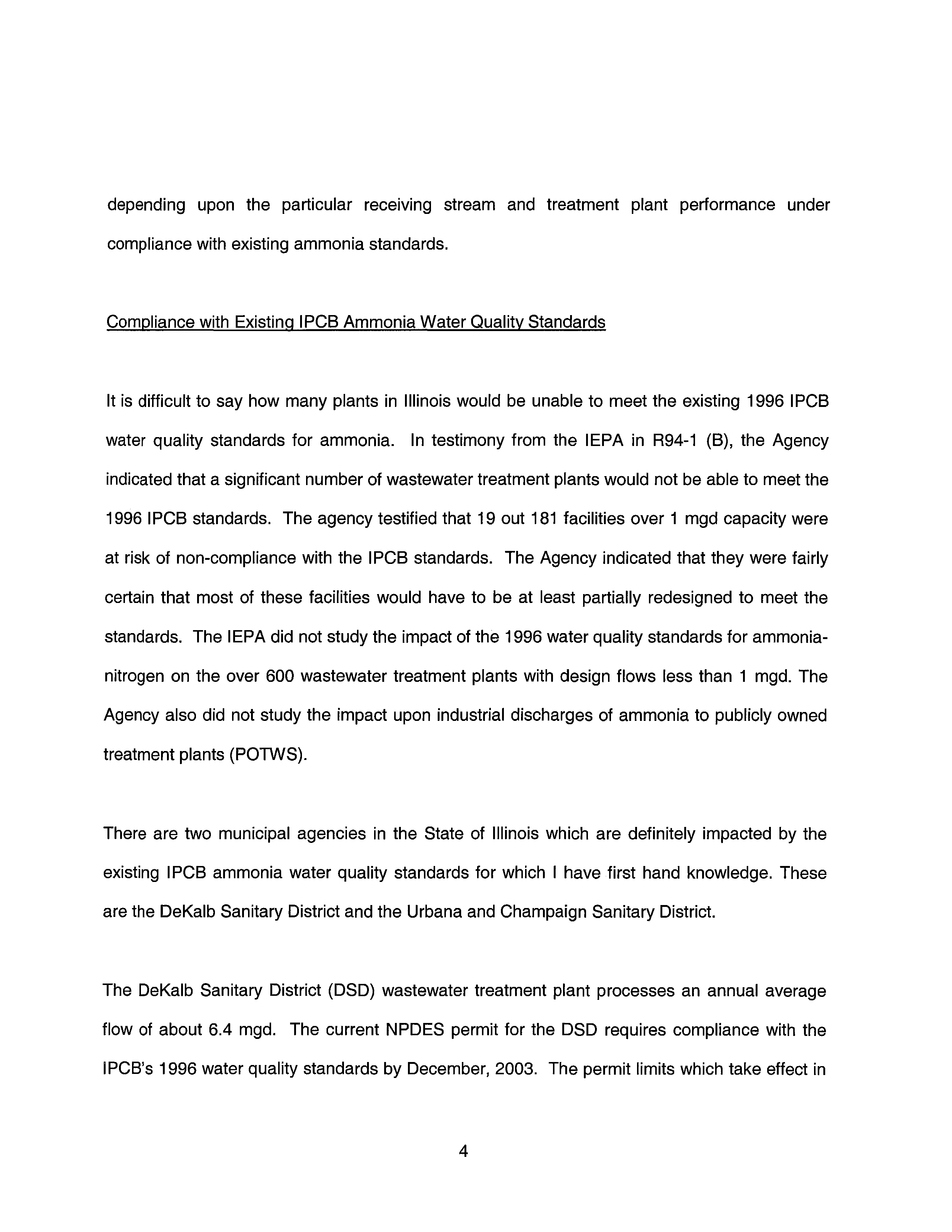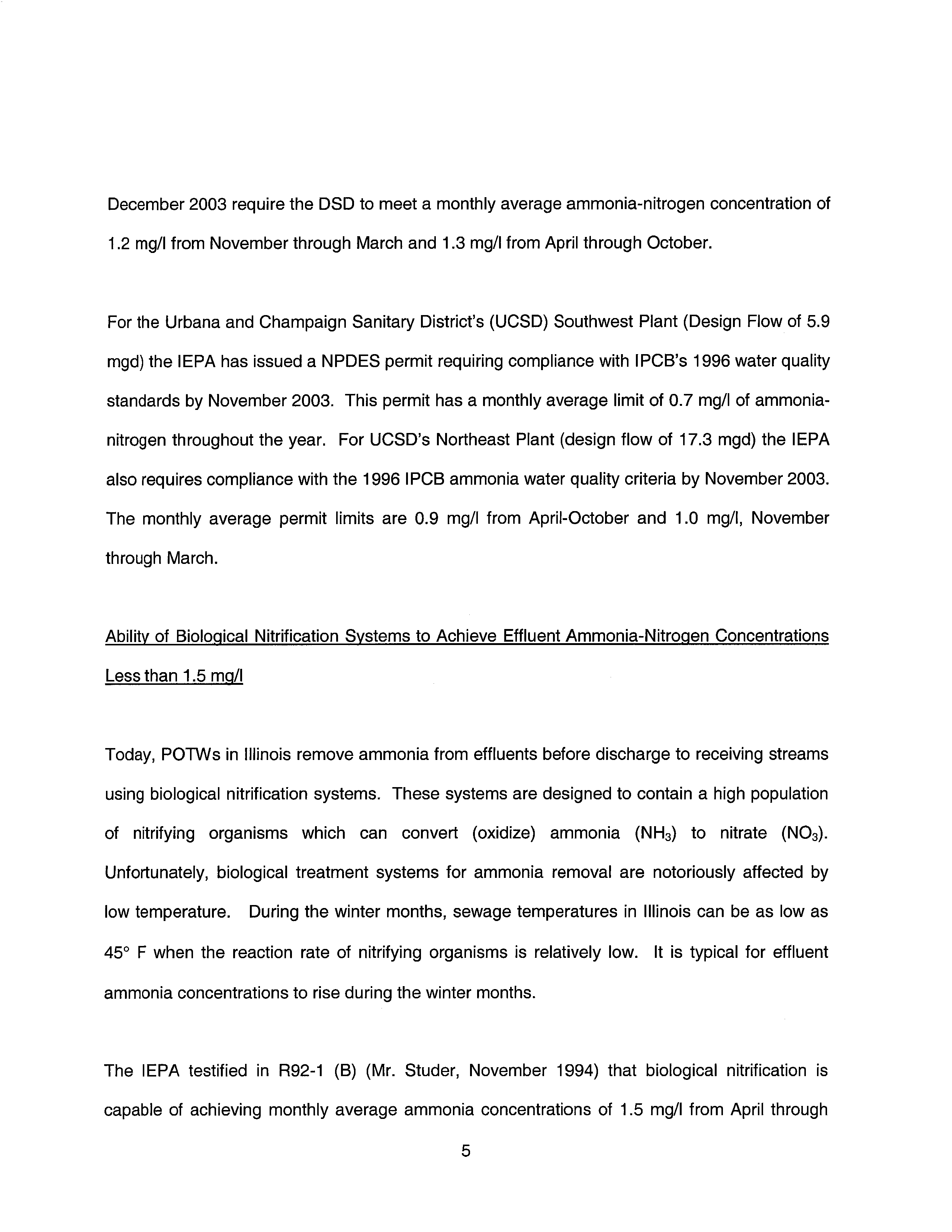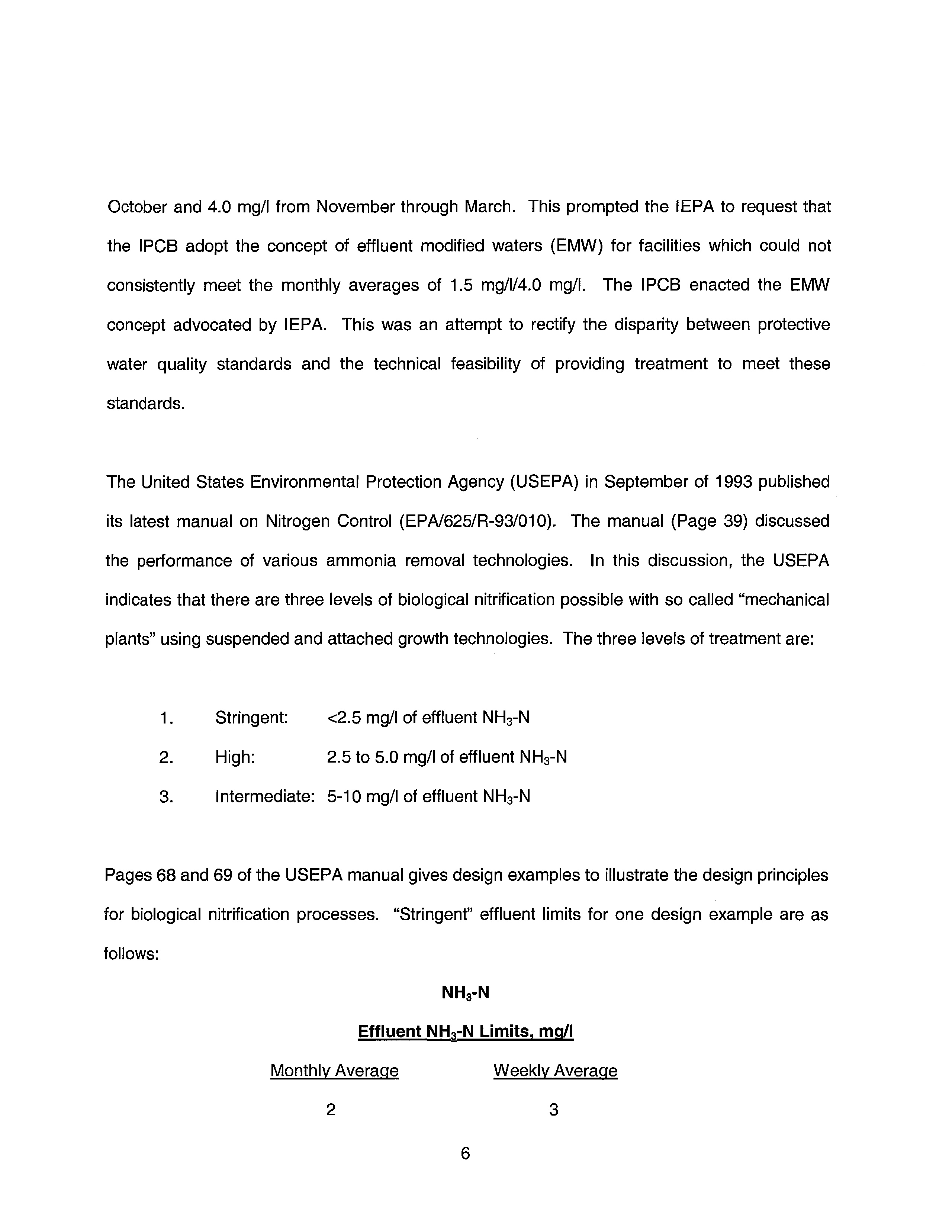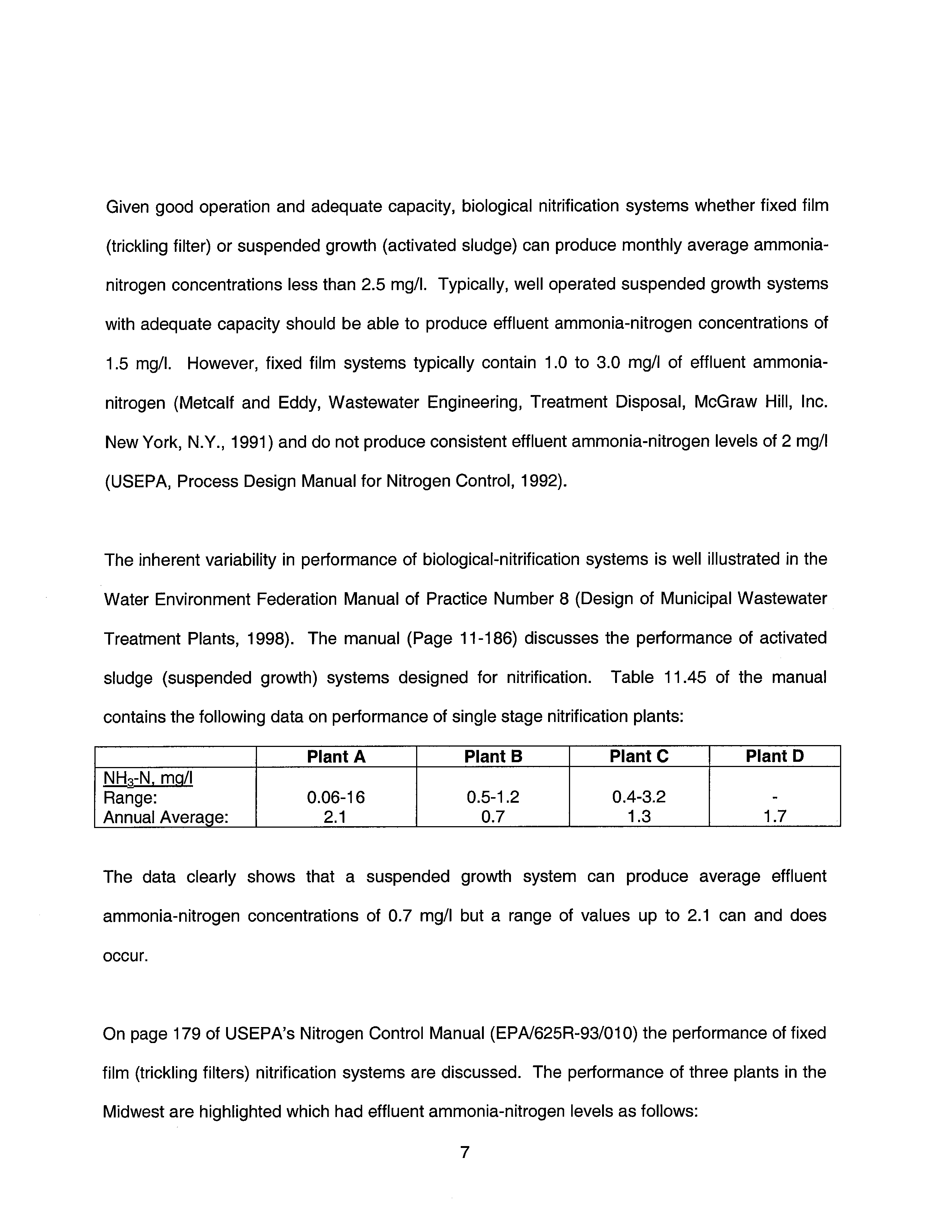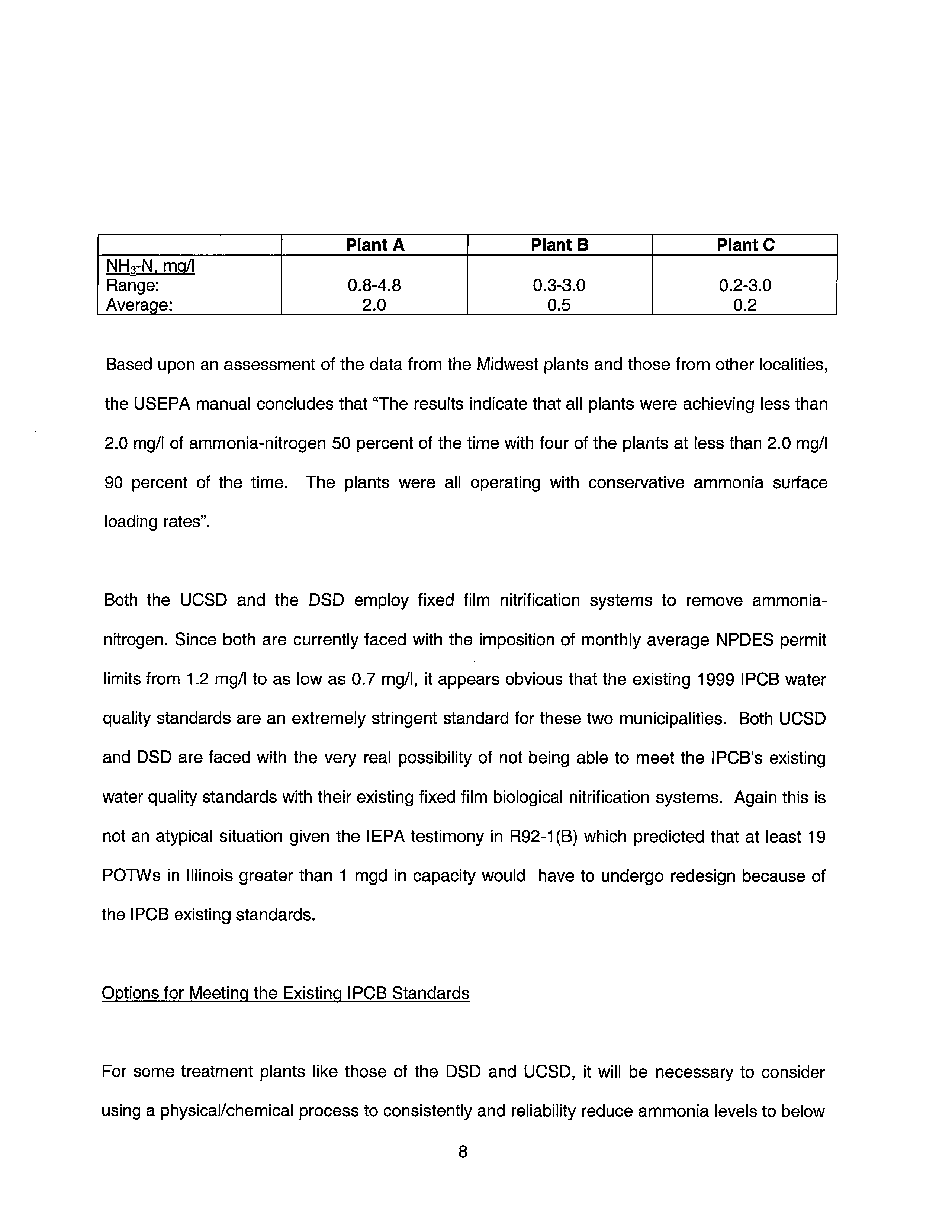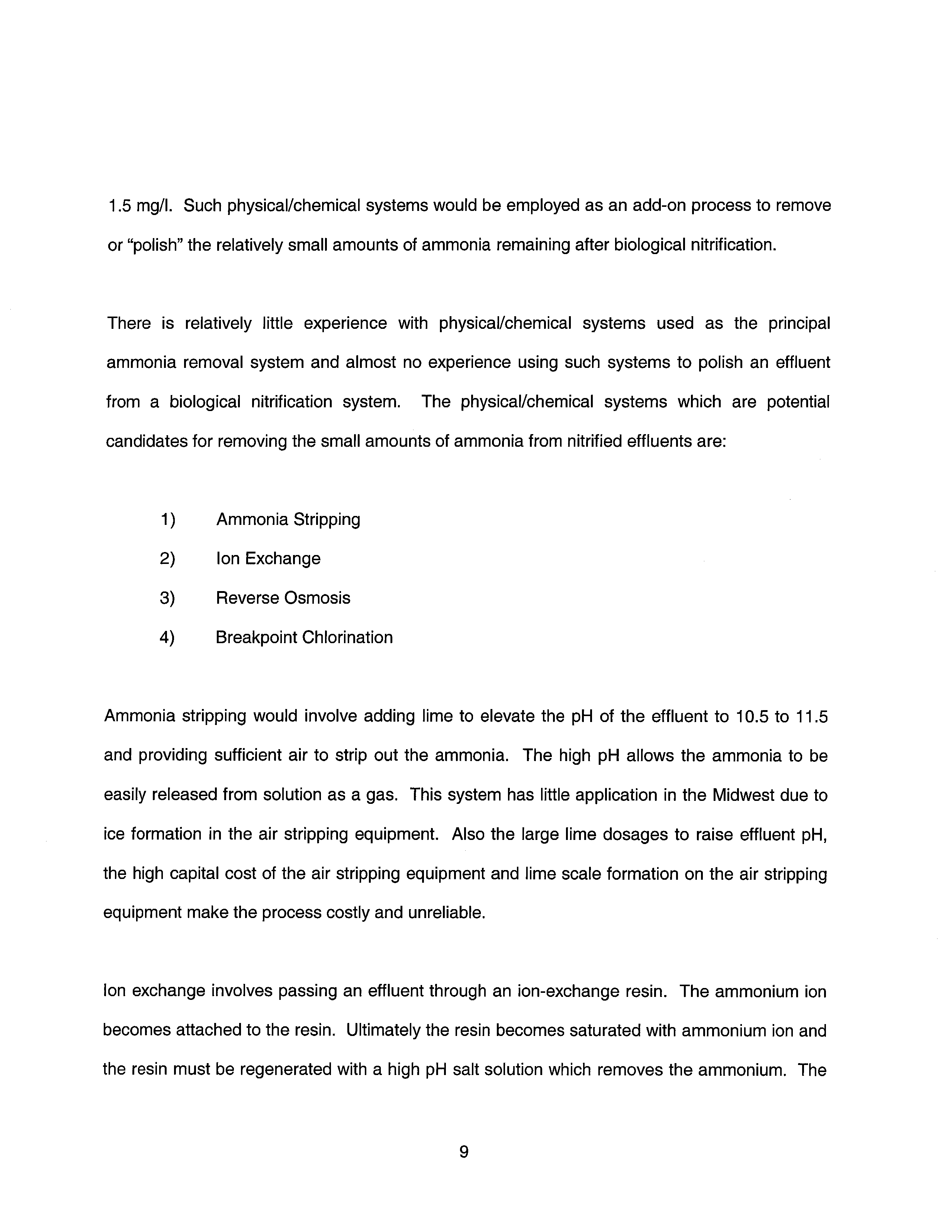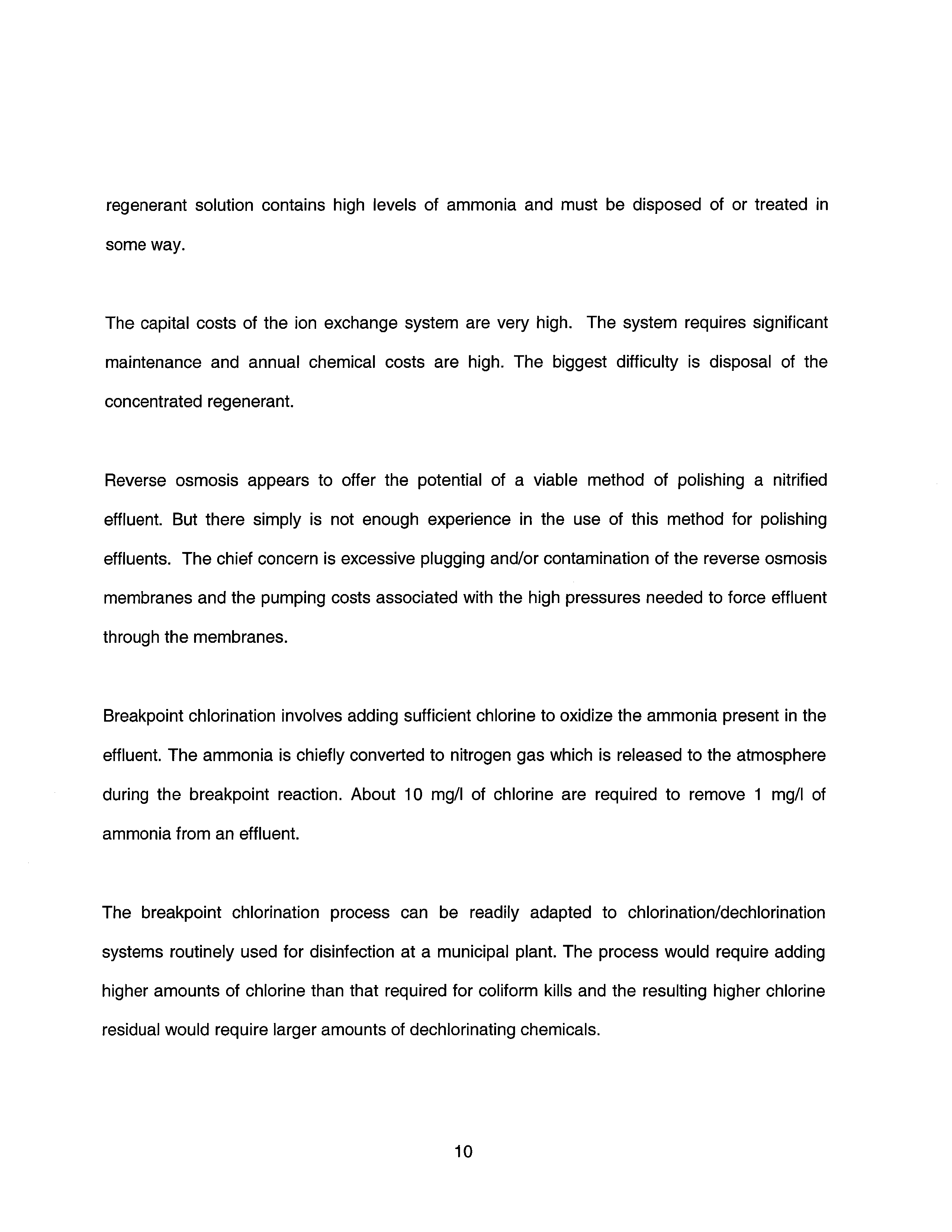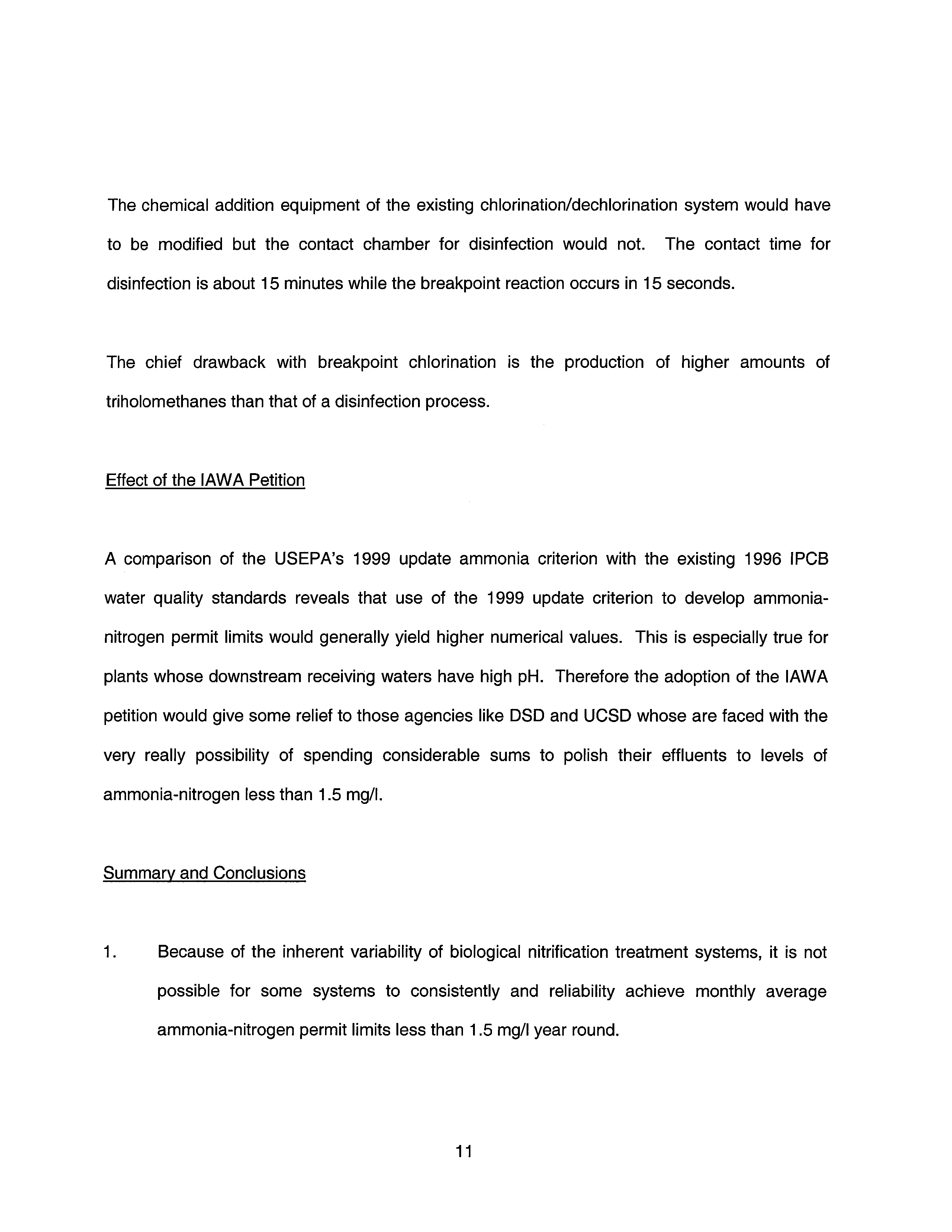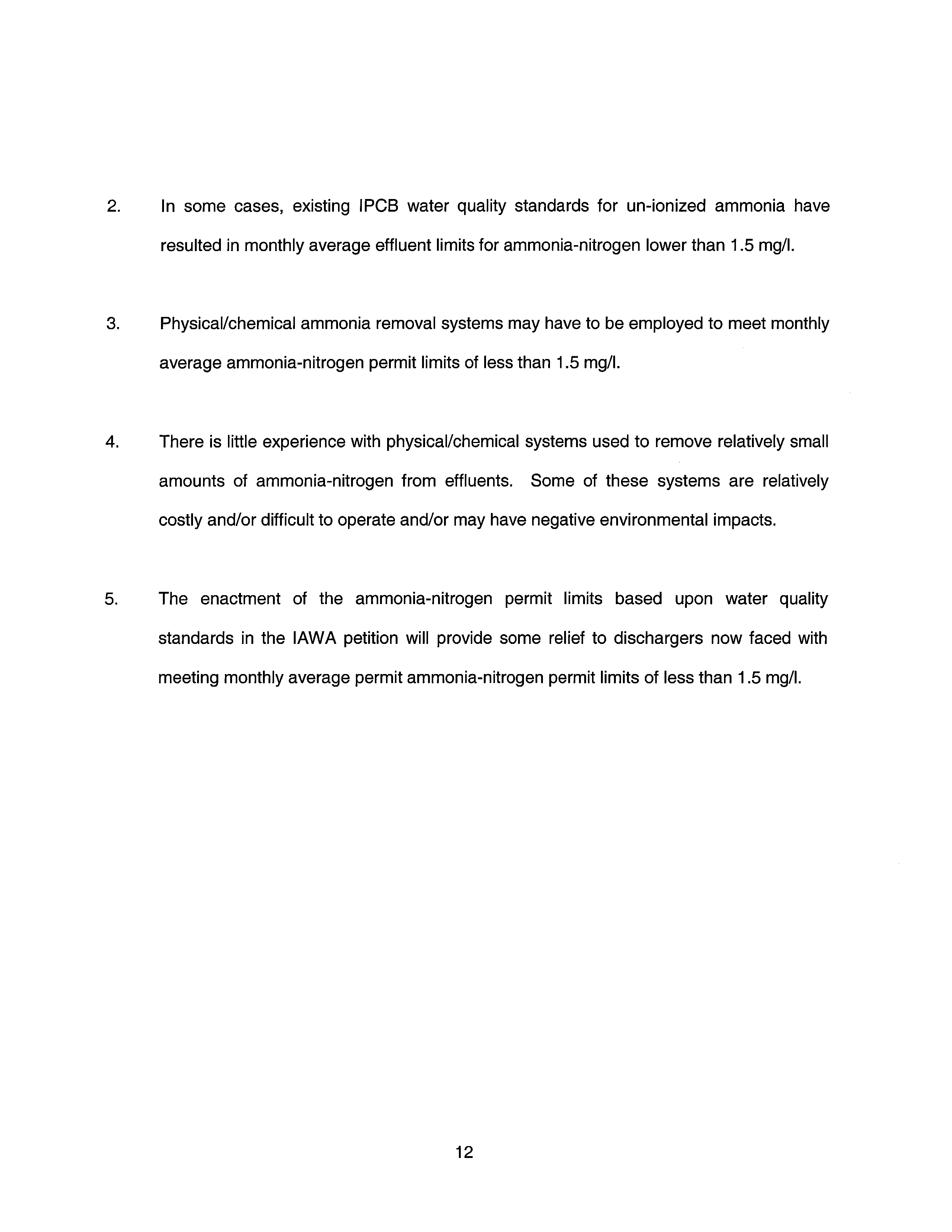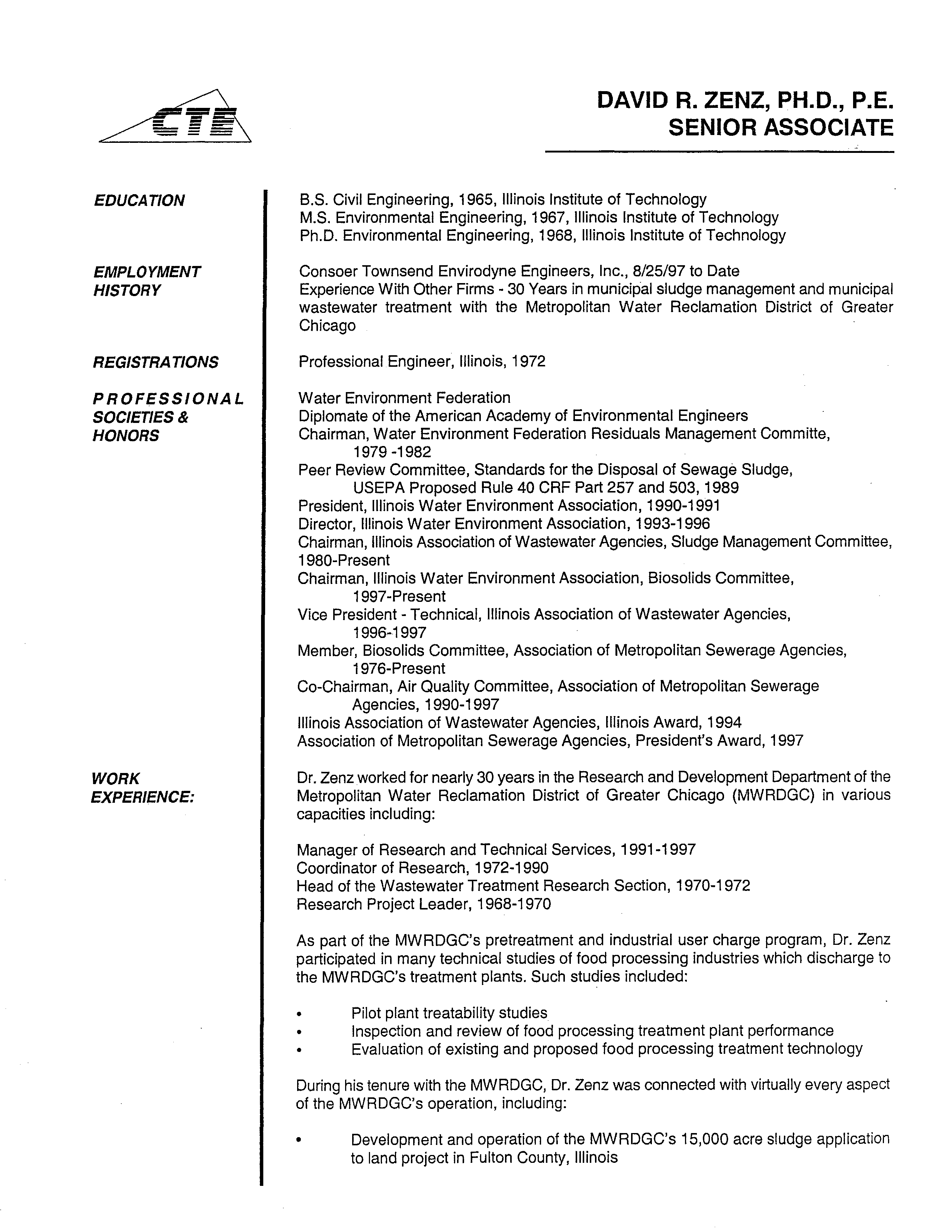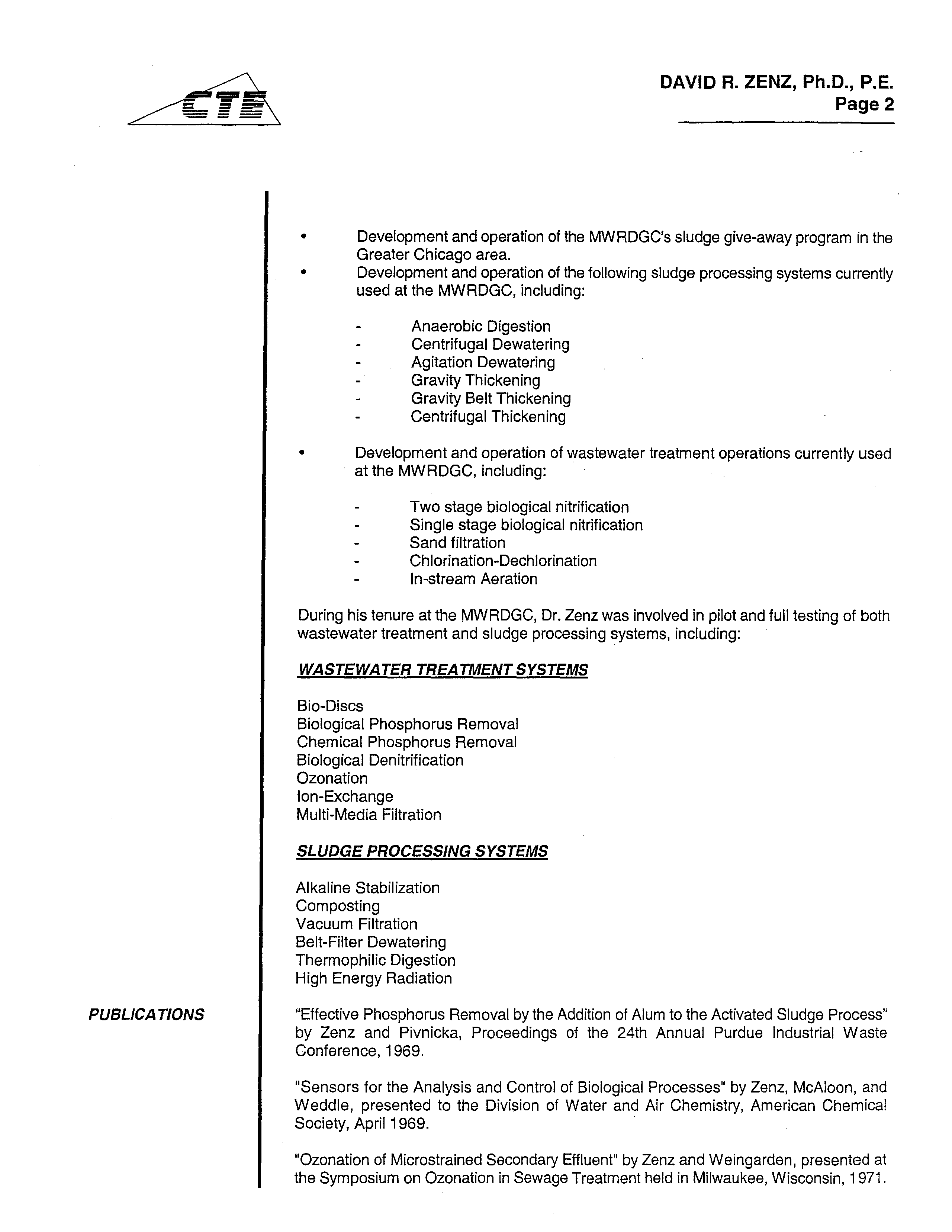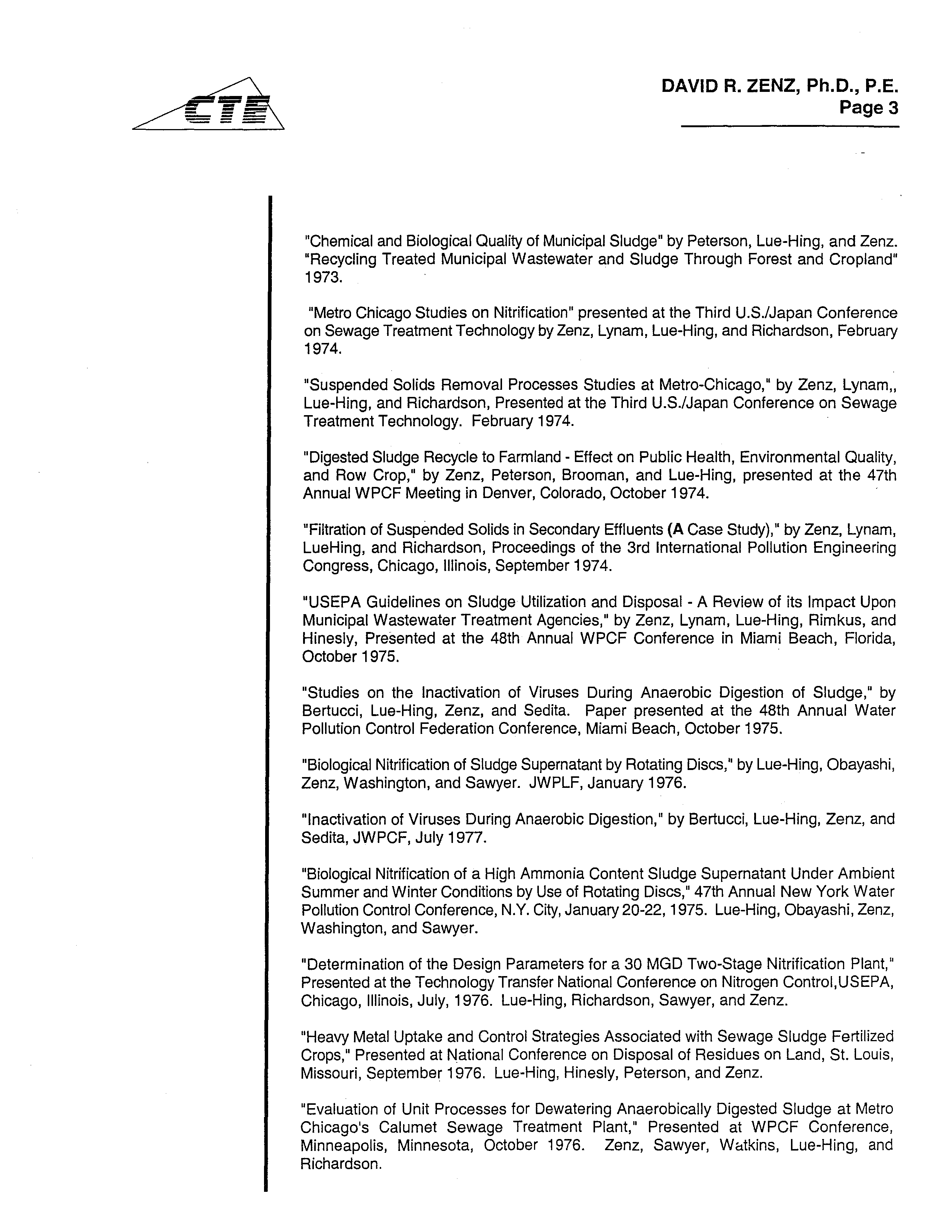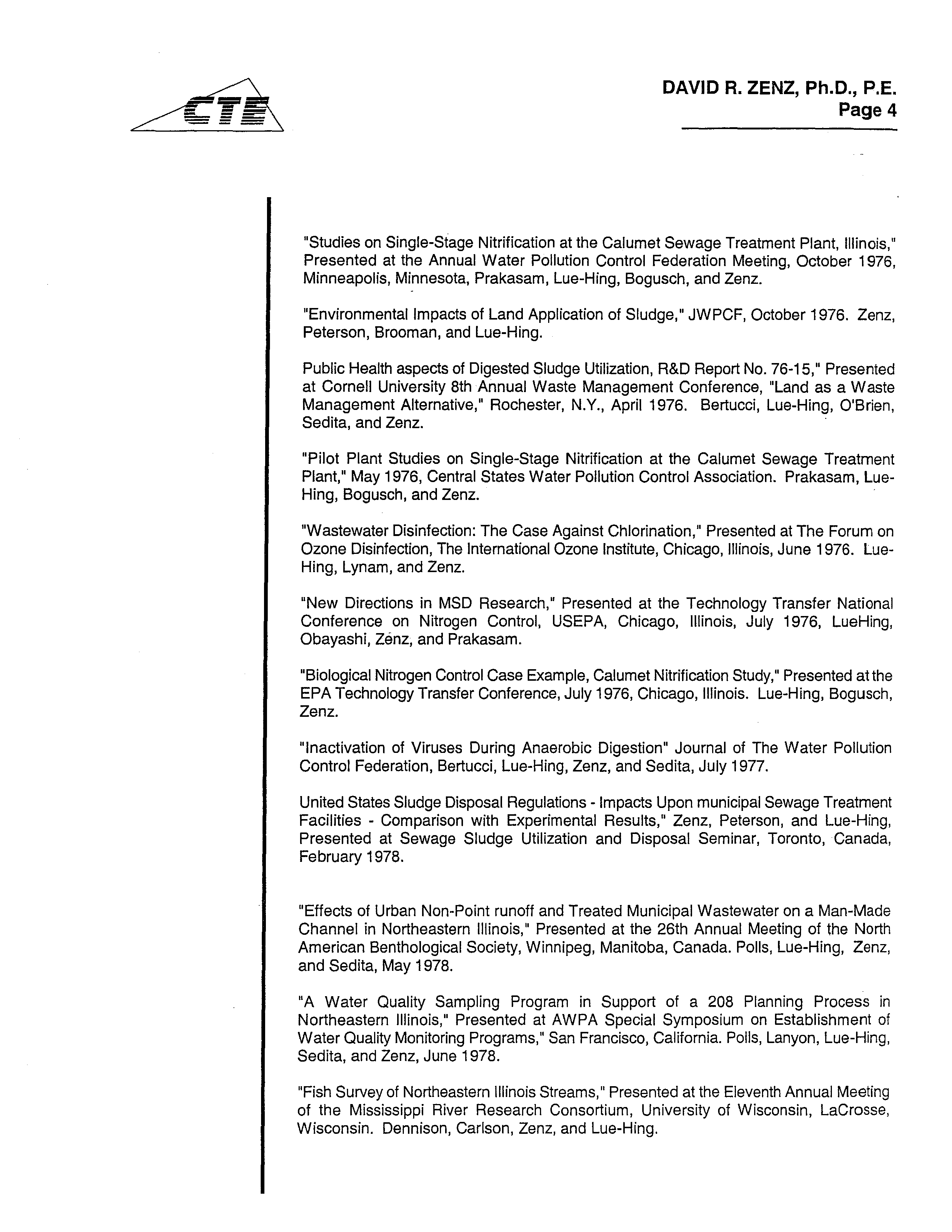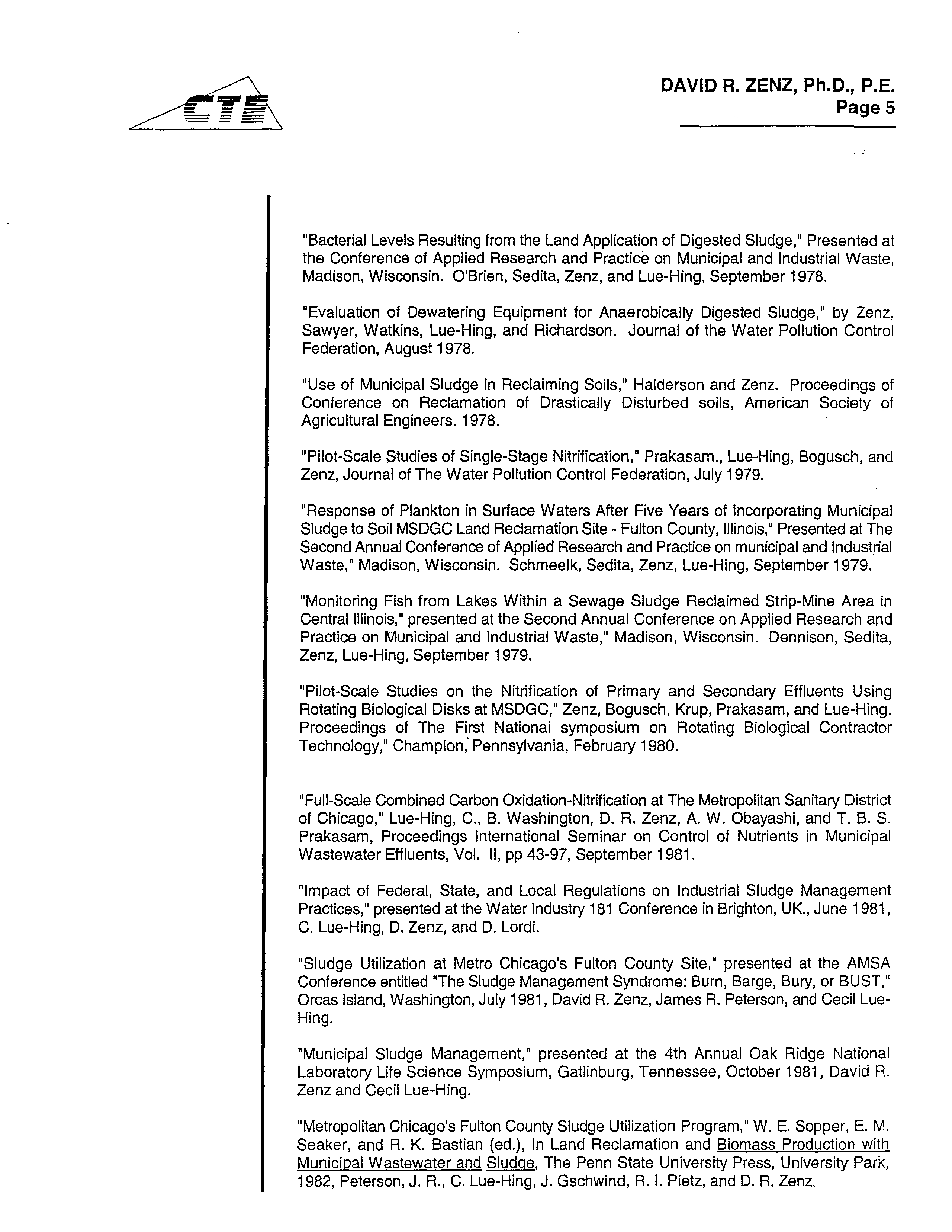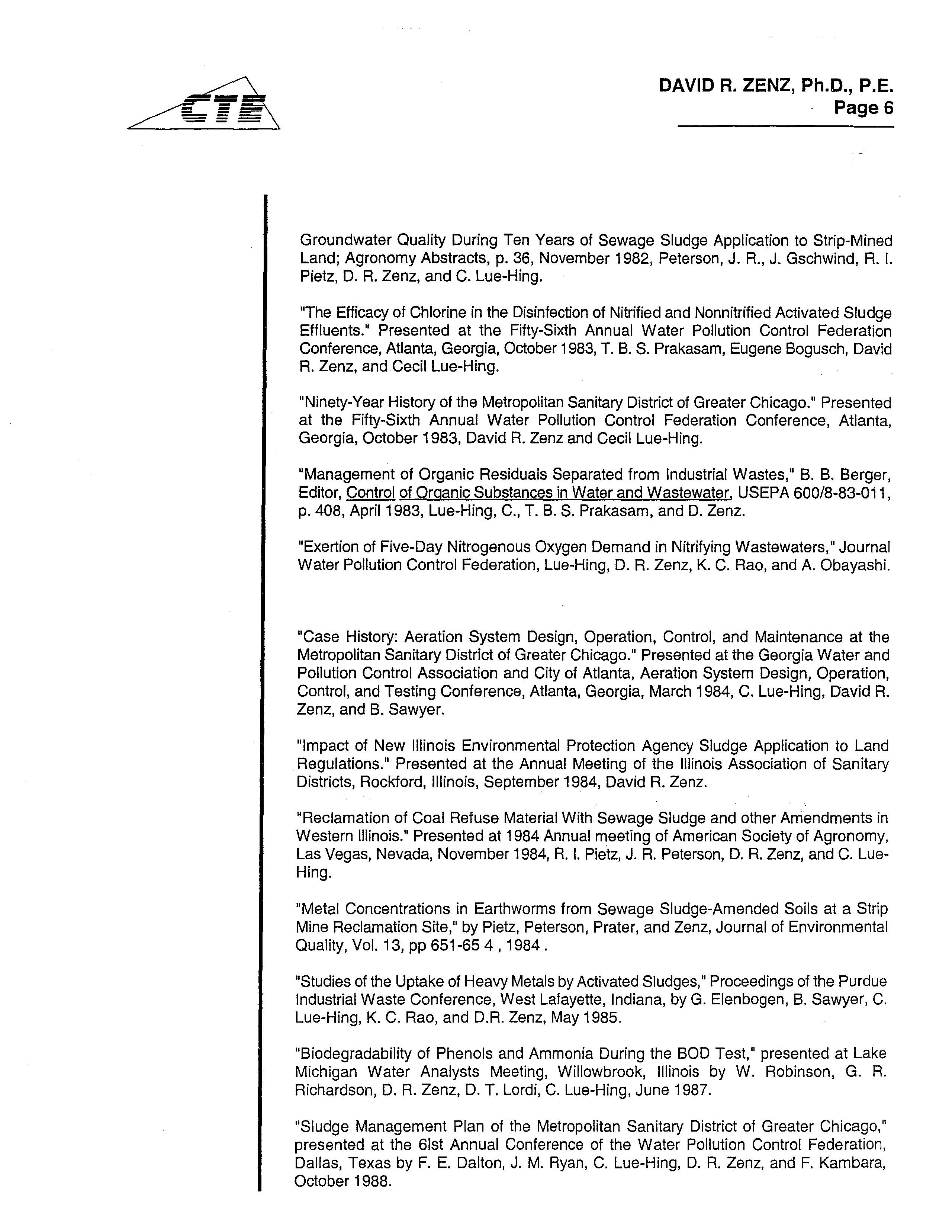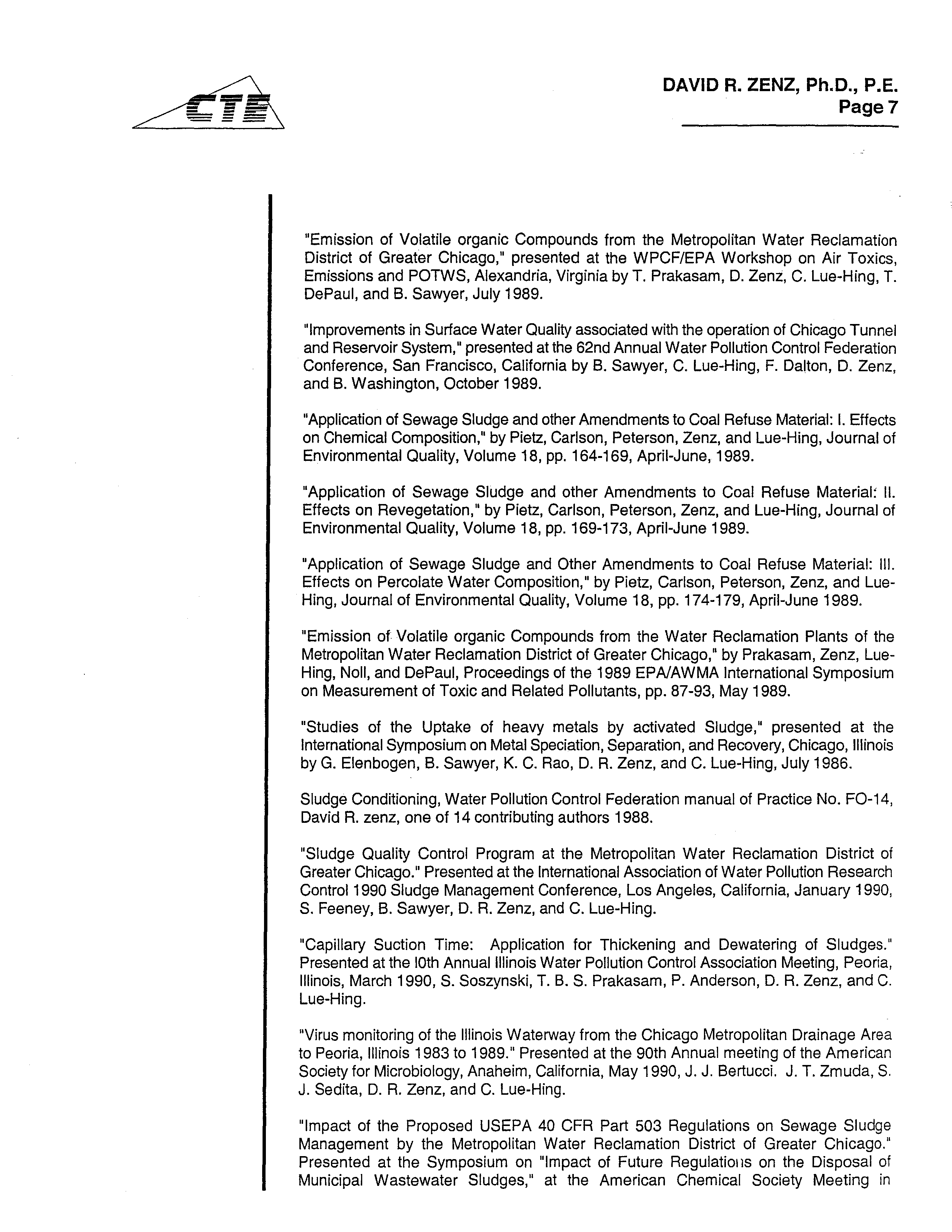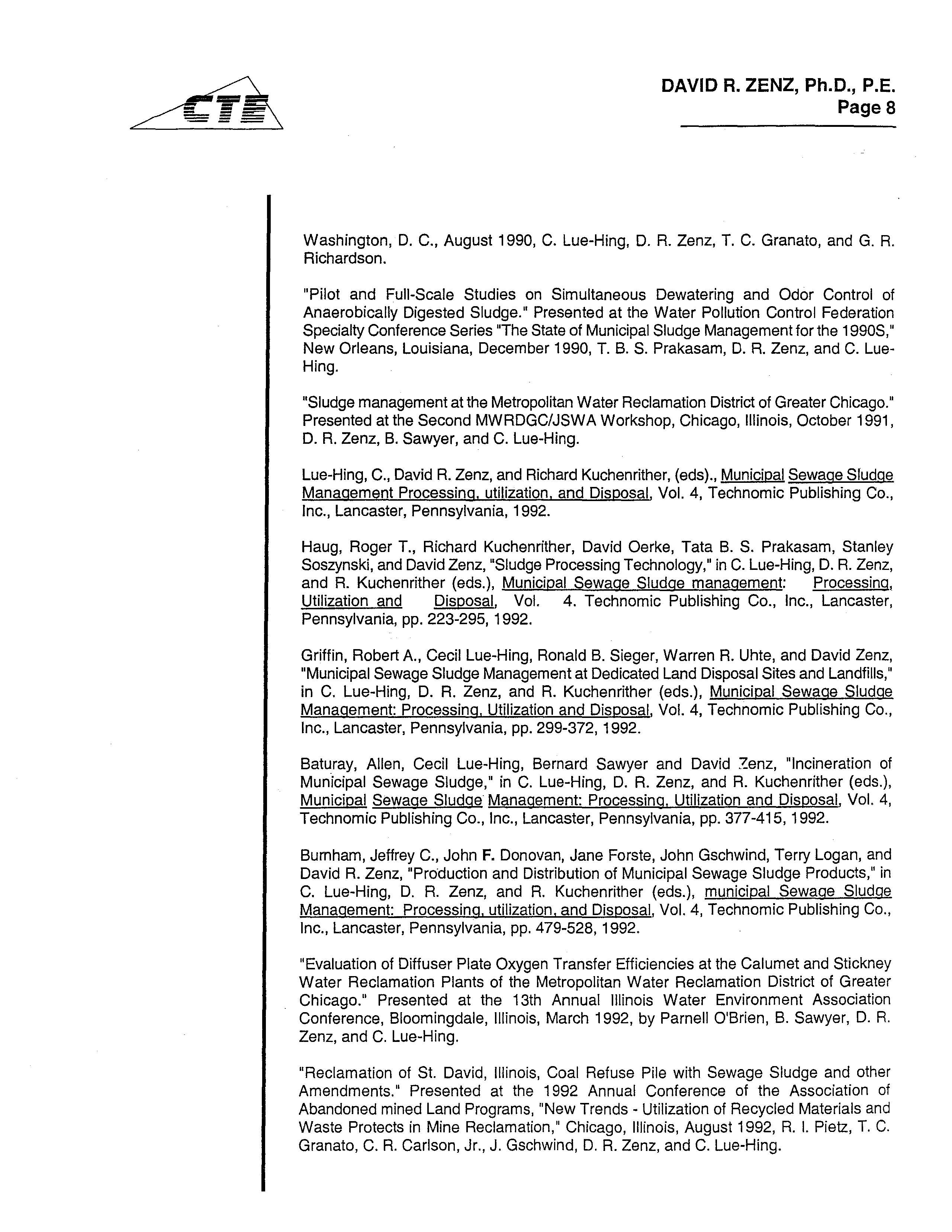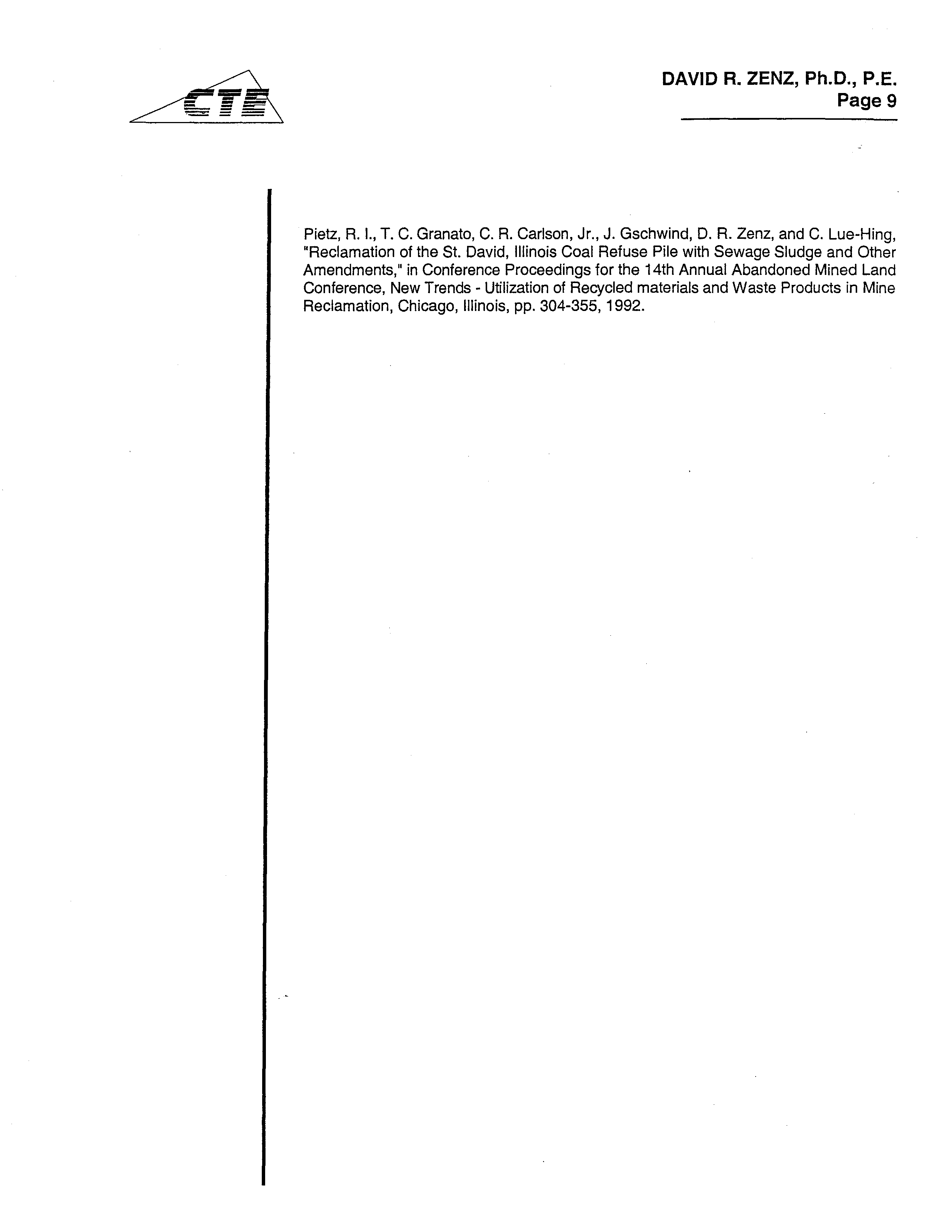| | - CONSOER TOWNSEND ENVIRODYNE ENGINEERS, INC.
- TESTIMONY PRESENTED TO THEILLINOIS POLLUTION CONTROL BOARD
- IN THE MATTER OF:
- PETITION OF THEILLINOIS ASSOCIATION OF WASTEWATER AGENCIES
- WATER QUALITY STANDARDSAMMONIA-NITROGEN
- DOCKET NUMBER: R 02-19
- MARCH 25, 2002
- R, ZENZ, P.E.SENIOR ASSOCIATE
- CONSOER TOWNSEND ENVIRODYNE ENGINEERS, INC.
- NH3-N
- NH3-N Limits, mqII
- DAVID A. ZENZ, PH~D.,PEE.SENIOR ASSOCIATE
- WASTEWATER TREATMENTSYSTEMS
- SLUDGE PROCESSING SYSTEMS
- DAVID R. ZENZ, Ph.D., P.E.Page 5
- Page 6
- Page 8
- DAVID R. ZENZ, Ph.D., P.E.Page 9
|
~T~\
ENGIf~~~i~
CONSOER TOWNSEND ENVIRODYNE EN~
~k~$NE.~
‘~
February 25, 2002
Please
find
enclosed
the testimony
of
Dr.
David
R.
Zenz,
P.
E.
to
be
presented
at
the
Illinois
Pollution
Control
Board
(IPCB)
Meeting
of
March 25, 2002.
This IPCB
meeting is scheduled for
10:30 a.m.
and will
take place at the James
R. Thompson Center in Chicago.
The
testimony
will
be
in
the
matter
of
the
Illinois
Association
of
Wastewater
Agency
(IAWA)
proposal
before
the
IPCB
regarding
ammonia-nitrogen water quality standards
in
Docket Number R02-1
9.
Please note that copies of the enclosed testimony
have
been sent to
all
persons on the existing service list for R02-1 9.
If you have
any questions,
please call
me at 312-938-0300 (ext. 4221).
Very truly yours,
CONSOER TOWNSEND ENVIRODYNE
ENGINEERS,
INC.
RECEIVED
CI~ER.~.K’S
OFFTCE
MAR
4
2002
STATE OF IWNOIS
Pollution
Control Board
303
East Wacker Drive
Suite 600
Chicago,
IL 60601-5276
Phone:
(312) 938 0300
Fax:
(312)
938
1109
Illinois
Pollution Control
Board
Attn: Dorothy
Gunn, Clerk
James
R. Thompson Center
100 West Randolph Street
Suite
11-500
Chicago,
IL.
60601
Subject:
Prefiled Testimony of Dr. David Zenz,
P.E.
Docket No.
R02-1 9
David R. Zenz,
Ph.D.,
P.
E.
Senior Associate
Cc:
M.
Callahan
M. Zima
D.
-
RECEiVED
CL~Rç’5 OPP1r~
MAR
4
2002
TESTIMONY PRESENTED TO THE
ILLINOIS POLLUTION
CONTROL BOARD
IN THE
MATTER OF:
STATE OF IWNOIS
Pollution Control Board
PETITION
OF THE
ILLINOIS ASSOCIATION OF WASTEWATER AGENCIES
WATER QUALITY STANDARDS
AMMONIA-NITROGEN
DOCKET NUMBER:
R 02-19
MARCH 25, 2002
BY
DR. DAVID
R, ZENZ,
P.E.
SENIOR ASSOCIATE
CONSOER TOWNSEND ENVIRODYNE
ENGINEERS, INC.
Introduction
The Illinois Association of Wastewater Agencies
(IAWA) has
presented
a proposal to the Illinois
Pollution
Control
Board
(IPCB)
requesting
that the
IPCB adopt
new water quality standards
for
ammonia-nitrogen
in the State
of Illinois.
The technical content of
the petition
is based upon the
United
States
Environmental
Protection
Agency’s
(USEPA’s)
1999
Update
of
Ambient
Water
Quality
Criteria for Ammonia
published
in
final
form
in
the
Federal
Register
on
December 22,
1999 (Vol. 64,
No.
245).
This update was prepared
by USEPA after an extensive
review of
the
available
literature
on
ammonia toxicity to
aquatic life.
In
the
1999 update,
USEPA
has
issued
freshwater aquatic life criteria for ammonia which supercedes
all previous criteria.
The
IPCB’s
existing water quality standards
for
un-ionized
and
total ammonia-nitrogen
in
Part
302
were issued
in
1996
Docket
Number R94-1 B.
Clearly, the
IPCB should carefully consider
the IAWA petition since the basis
of the IAWA’s Petition
is the USEPA’s 1999
update.
The
1999
update
indicates
that
the
states
should
consider
the
USEPA’s
1999
ambient
water
quality
criteria
for ammonia
in the development of water quality criteria standards which are
protective
of
aquatic
life.
Since
the
1999
update
serves
as
a
guide
to
the
states
in
developing
water
quality standards for ammonia, the IAWA petition should
be given serious consideration
by the
IPCB.
Focus of Testimony
My testimony will
focus on
the issue
of
the capabilities
of wastewater treatment technology
to
meet ammonia-nitrogen National
Pollutant Discharge
Elimination System
(NPDES) permit
limits
1
which would
ultimately result from
IPCB’s existing ammonia water quality standards. This
issue
was
considered by the
IPCB when
it
deliberated the existing
IPCB water quality standards
for
ammonia based upon the previous version of the national
guidance which has been superceded
by the
1999 updated guidance document for ammonia.
Credentials
I
have a
Bachelor of
Science Degree
in
Civil Engineering
and
Master of
Science
and
Doctor of
Philosophy
Degrees
in
Environmental
Engineering.
All
these
degrees
are
from
the
Illinois
Institute of Technology.
I
received
my
Illinois
Professional
Engineering
License
in
1972.
The license
number
is 062-
031137.
I
was certified through examination by the American Academy of
Environmental Engineers as a
specialist
in wastewater treatment in
1986.
The certificate number is 86-20007.
For
thirty
years,
I
was
employed
in
the
Research
and
Development
Department
of
the
Metropolitan Water
Reclamation District of
Greater Chicago (MWRDGC).
For my entire
career
at
the
MWRDGC,
I
worked
in
the
Research
and
Technical
Services
Division
which
is
responsible
for
developing
wastewater treatment
processes
for
use
by the
MWRDGC,
I
was
employed
by the
MWRDGC
from
1967 through
1997
during
which
the
MWRDGC
developed
and
implemented
biological
nitrification
(ammonia
removal)
processes
to
meet
IPCB
water
quality standards for ammonia.
2
Since
leaving
the MWRDGC
in
1997,
I
have
been
employed
at
Consoer Townsend
Envirodyne
Engineers,
Inc.
(CTE) where
I
have been working with
clients
who have
been struggling
to
meet
the
ammonia
water
quality standards adopted by the
IPCB
in
R94-1(B).
Most
notably
these
clients
are the Urbana and Champaign
Sanitary District
and the DeKaIb
Sanitary District.
I
have
published
and/or
presented
over
70
technical
papers
on
wastewater
treatment
and
biosolids management.
Ten of
these
technical
papers deal
with
biological
nitrification.
A
full
listing
of these technical
papers are contained
in the attached resume.
I
have
received
a
number of
awards.
Most
notably,
I
received the Presidents Award from
the
Association
of
Metropolitan
Sewerage
Agencies
and
the Sidney Bedell
Award
from
the Water
Environment
Federation.
In
1998,
I
was
named
the
Alva
Todd
Professor
because
of
accomplishments
as
an
Adjunct
Professor
in
the
Department
of
Environmental
Engineering
at
the Illinois Institute
of Technology.
A complete resume giving the details of my education
and experience is attached.
Permit Limits Based upon
Existinci
IPCB Water Quality Standards for Ammonia-Nitrogen
The
IPCB
enacted
the
existing
water
quality
standards for
ammonia
in
1996.
These
water
quality
standards
(Section
302)
include
numerical
values
for
un-ionized
ammonia-nitrogen,
which
are
converted by the IEPA
into
site specific
NPDES
permit limits.
Basically,
IEPA
uses
available
receiving
stream
data
on
flow,
temperature
and
pH
to
calculate
ammonia-nitrogen
permit
limits
for
a
particular
treatment
plant.
Of
course,
permit
limits
are
highly
variable
3
depending
upon
the
particular
receiving
stream
and
treatment
plant
pertormance
under
compliance with
existing ammonia standards.
Compliance with
Existing IPCB
Ammonia Water Quality Standards
It is difficult to say
how
many plants
in
Illinois would
be
unable to meet the existing 1996
IPCB
water
quality standards
for
ammonia.
In
testimony
from
the
IEPA
in
R94-1
(B),
the Agency
indicated that a significant number of wastewater treatment plants would not
be able to
meet the
1996
IPCB standards.
The agency testified that
19
out
181
facilities over
1
mgd
capacity were
at
risk of
non-compliance
with the
IPCB
standards.
The Agency
indicated
that they were fairly
certain
that
most
of
these
facilities
would
have
to
be
at
least
partially
redesigned
to
meet the
standards.
The IEPA did
not study the impact of the 1996 water quality standards for ammonia-
nitrogen
on the over
600 wastewater treatment plants
with
design
flows
less
than
1
mgd.
The
Agency
also
did
not study the impact
upon
industrial
discharges of
ammonia to publicly
owned
treatment plants (POTWS).
There
are
two
municipal
agencies
in
the State
of
Illinois
which
are
definitely
impacted
by the
existing
IPCB
ammonia
water
quality
standards for which
I
have
first
hand
knowledge.
These
are the DeKaIb Sanitary District and the Urbana and Champaign Sanitary District.
The
DeKaIb
Sanitary
District (DSD)
wastewater treatment plant
processes an
annual
average
flow
of
about
6.4
mgd.
The
current
NPDES
permit for
the DSD
requires
compliance with
the
IPCB’s
1996 water
quality standards by December, 2003.
The permit
limits which take effect in
4
December 2003
require the DSD to
meet a monthly average ammonia-nitrogen concentration
of
1.2
mg/I from
November through March and
1.3 mg/I from April through October.
For the Urbana and Champaign Sanitary District’s (UCSD) Southwest Plant
(Design
Flow of
5.9
mgd) the IEPA has issued a NPDES permit requiring compliance with
IPCB’s 1996 water quality
standards
by November 2003.
This permit
has a
monthly average limit of 0.7 mg/I
of ammonia-
nitrogen
throughout the year.
For UCSD’s
Northeast
Plant
(design flow of
17.3
mgd)
the IEPA
also requires compliance with the 1996 IPCB ammonia water quality criteria
by November 2003.
The
monthly
average
permit
limits
are
0.9
mg/I
from
April-October
and
1 .0
mg/I,
November
through March.
Ability of
Biological
Nitrification
Systems
to Achieve Effluent Ammonia-Nitrogen
Concentrations
Less than
1.5 mg/I
Today, POTWs
in
Illinois
remove ammonia from
effluents before discharge
to receiving
streams
using biological
nitrification
systems.
These
systems are designed to contain
a
high
population
of
nitrifying
organisms
which
can
convert
(oxidize)
ammonia
(NH3)
to
nitrate
(NO3).
Unfortunately,
biological
treatment systems
for
ammonia
removal
are
notoriously
affected
by
low temperature.
During the winter
months, sewage temperatures
in
Illinois
can
be
as low
as
45°F
when
the reaction
rate of
nitrifying organisms
is
relatively
low.
It
is typical
for
effluent
ammonia concentrations to rise
during the winter months.
The
IEPA
testified
in
R92-1
(B)
(Mr.
Studer,
November
1994)
that
biological
nitrification
is
capable
of
achieving
monthly
average
ammonia
concentrations
of
1.5 mg/I
from
April
through
5
October and
4.0
mg/I
from
November through March.
This prompted the IEPA
to
request
that
the
IPCB
adopt
the
concept
of
effluent
modified
waters
(EMW)
for
facilities
which
could
not
consistently
meet the
monthly
averages
of
1.5
mg/l/4.0
mg/I.
The
IPCB
enacted
the
EMW
concept
advocated
by
IEPA.
This was
an
attempt to
rectify
the
disparity between
protective
water
quality
standards
and
the
technical
feasibility
of
providing
treatment
to
meet
these
standards.
The United
States
Environmental Protection
Agency (USEPA)
in
September of
1993
published
its
latest manual
on
Nitrogen
Control (EPA/625/R-93/010).
The
manual
(Page
39)
discussed
the
performance
of
various
ammonia
removal
technologies.
In
this
discussion,
the
USEPA
indicates that there
are three levels of
biological
nitrification
possible with
so called
“mechanical
plants”
using suspended and attached growth technologies.
The three levels of treatment are:
1.
Stringent:
2.5
mg/I of
effluent NH3-N
2.
High:
2.5 to 5.0 mg/I of
effluent NH3-N
3.
Intermediate:
5-10
mg/I of
effluent NH3-N
Pages 68 and 69 of the USEPA manual gives design
examples to
illustrate the design principles
for
biological
nitrification
processes.
“Stringent”
effluent
limits
for
one
design
example are
as
follows:
NH3-N
Effluent
NH3-N Limits, mqII
Monthly Average
Weekly Average
2
3
6
Given
good operation
and
adequate
capacity,
biological
nitrification
systems whether fixed
film
(trickling filter) or suspended growth
(activated
sludge) can
produce monthly
average ammonia-
nitrogen concentrations less than 2.5
mg/I.
Typically,
well operated
suspended
growth
systems
with adequate
capacity should
be
able to
produce
effluent ammonia-nitrogen concentrations of
1.5
mg/I.
However,
fixed
film
systems
typically contain
1 .0
to
3.0
mg/I
of
effluent
ammonia-
nitrogen
(Metcalf
and
Eddy,
Wastewater
Engineering,
Treatment
Disposal,
McGraw
Hill,
Inc.
New York,
N.Y.,
1991) and do not produce consistent effluent ammonia-nitrogen levels of
2 mg/I
(USEPA,
Process
Design Manual for Nitrogen Control,
1992).
The inherent variability
in
performance of
biological-nitrification
systems
is well
illustrated in the
Water
Environment Federation
Manual
of
Practice
Number 8
(Design
of
Municipal Wastewater
Treatment
Plants,
1998).
The manual
(Page
11-1 86)
discusses the
performance
of
activated
sludge
(suspended
growth)
systems
designed
for
nitrification.
Table
11 .45
of
the
manual
contains the following data on
performance of single stage nitrification plants:
Plant
A
Plant
B
Plant C
Plant D
NH3-N.
mg/I
Range:
0.06-16
0.5-1.2
0.4-3.2
Annual Average:
2.1
0.7
1.3
-
1.7
The
data
clearly
shows
that
a
suspended
growth
system
can
produce
average
effluent
ammonia-nitrogen
concentrations
of
0.7
mg/I
but
a
range
of
values
up
to
2.1
can
and
does
occur.
On
page 179 of
USEPA’s Nitrogen
Control
Manual
(EPN625R-93/01 0) the performance of fixed
film
(trickling filters)
nitrification
systems
are discussed.
The performance of
three
plants
in the
Midwest are
highlighted which had
effluent ammonia-nitrogen levels as follows:
7
Plant A
Plant
B
Plant C
NH3-N,
mg/I
Range:
0.8-4.8
0.3-3.0
0.2-3.0
Average:
2.0
0.5
0.2
Based upon an assessment of the data from
the Midwest plants
and those from other localities,
the USEPA manual
concludes that “The results
indicate that all
plants were achieving
less than
2.0 mg/I
of ammonia-nitrogen 50
percent of
the time with four of the plants at
less than 2.0 mg/I
90
percent
of
the
time.
The
plants
were
all
operating
with
conservative
ammonia
surface
loading
rates”.
Both
the
UCSD
and
the
DSD
employ fixed
film
nitrification
systems
to
remove
ammonia-
nitrogen.
Since
both
are
currently faced with
the imposition
of
monthly
average NPDES
permit
limits from
1.2
mg/I to
as
low
as 0.7
mg/I,
it appears obvious
that the existing 1999
IPCB
water
quality standards are
an
extremely stringent standard for these
two municipalities.
Both UCSD
and
DSD
are
faced
with
the very
real
possibility
of
not
being
able to
meet the IPCB’s
existing
water
quality standards with their existing fixed film biological
nitrification
systems.
Again this is
not an
atypical situation given the IEPA testimony
in
R92-1(B)
which predicted that
at least
19
POTWs
in
Illinois greater than
1
mgd
in
capacity would
have
to
undergo
redesign
because
of
the IPCB existing standards.
Options for
Meeting the Existing
IPCB Standards
For
some treatment plants
like those
of
the
DSD
and
UCSD,
it
will
be
necessary
to
consider
using a physical/chemical process
to consistently and
reliability reduce ammonia levels to below
8
1.5 mg/I.
Such physical/chemical systems would
be employed as
an add-on
process
to
remove
or “polish” the relatively small amounts of
ammonia remaining after biological nitrification.
There
is
relatively
little
experience
with
physical/chemical
systems
used
as
the
principal
ammonia
removal system
and
almost
no experience
using
such
systems
to
polish
an
effluent
from
a
biological
nitrification
system.
The
physical/chemical
systems
which
are
potential
candidates for
removing the small amounts of ammonia from nitrified
effluents are:
1)
Ammonia Stripping
2)
Ion Exchange
3)
Reverse Osmosis
4)
Breakpoint Chlorination
Ammonia
stripping
would
involve
adding
lime
to
elevate
the
pH
of the effluent
to
10.5
to
11.5
and
providing
sufficient air
to strip
out the ammonia.
The
high
pH
allows the
ammonia
to
be
easily released from
solution
as a
gas.
This system
has
little application
in
the Midwest due
to
ice
formation
in
the air
stripping equipment.
Also the large
lime dosages
to
raise
effluent
pH,
the
high capital cost of
the air stripping
equipment
and
lime scale formation
on the air stripping
equipment make the process costly and
unreliable.
Ion
exchange
involves
passing
an
effluent through
an
ion-exchange resin.
The ammonium
ion
becomes attached
to
the resin.
Ultimately the
resin becomes saturated with ammonium
ion
and
the resin
must
be
regenerated with
a
high
pH
salt solution which removes the ammonium.
The
9
regenerant
solution
contains
high
levels
of
ammonia
and
must
be
disposed
of
or treated
in
some way.
The capital
costs
of
the
ion
exchange
system
are
very
high.
The
system
requires
significant
maintenance
and
annual
chemical
costs
are
high.
The
biggest
difficulty
is
disposal
of
the
concentrated regenerant.
Reverse
osmosis
appears
to
offer
the
potential
of
a
viable
method
of
polishing
a
nitrified
effluent.
But
there simply
is
not
enough
experience
in
the
use
of
this
method
for
polishing
effluents.
The chief concern is excessive
plugging and/or contamination
of the reverse osmosis
membranes
and the pumping costs associated with the high pressures
needed to force effluent
through the membranes.
Breakpoint chlorination
involves adding
sufficient chlorine
to oxidize
the ammonia present
in the
effluent. The ammonia is chiefly converted to
nitrogen
gas which is released to the atmosphere
during the
breakpoint
reaction.
About
10
mg/I
of
chlorine
are
required
to
remove
1
mg/I
of
ammonia from an
effluent.
The
breakpoint
chlorination
process
can
be
readily
adapted
to
chlorination/dechlorination
systems
routinely
used
for
disinfection
at
a
municipal
plant.
The
process would
require
adding
higher amounts
of
chlorine than that
required for
coliform
kills and
the
resulting
higher chlorine
residual
would require larger amounts of
dechlorinating chemicals.
10
The chemical
addition
equipment
of the existing chlorination/dechlorination
system would
have
to
be
modified
but
the
contact
chamber
for
disinfection
would
not.
The
contact
time
for
disinfection
is about
15 minutes while the breakpoint reaction occurs in
15 seconds.
The
chief
drawback
with
breakpoint
chlorination
is
the
production
of
higher
amounts
of
triholomethanes than
that of
a disinfection
process.
Effect of the IAWA Petition
A
comparison
of
the
USEPA’s
1999
update
ammonia
criterion
with
the
existing
1996
IPCB
water
quality
standards
reveals
that
use
of
the
1999
update
criterion
to
develop
ammonia-
nitrogen
permit
limits
would
generally yield higher
numerical
values.
This is especially true for
plants
whose downstream
receiving
waters
have high
pH.
Therefore the adoption
of the IAWA
petition would give
some relief
to those agencies
like DSD and
UCSD whose are faced with the
very
really
possibility
of
spending
considerable
sums
to
polish
their
effluents
to
levels
of
ammonia-nitrogen less than
1.5
mg/I.
Summary and
Conclusions
1.
Because
of
the
inherent variability
of
biological
nitrification
treatment systems,
it
is not
possible
for
some
systems
to
consistently
and
reliability
achieve
monthly
average
ammonia-nitrogen permit limits
less than
1 .5 mg/I year round.
11
2.
In
some
cases,
existing
IPCB
water
quality
standards
for
un-ionized
ammonia
have
resulted in
monthly average effluent
limits for ammonia-nitrogen lower than
1.5 mg/I.
3.
Physical/chemical ammonia
removal systems may have to
be employed to meet monthly
average ammonia-nitrogen permit limits of less than
1.5 mg/I.
4.
There is
little experience with
physical/chemical
systems used to
remove
relatively
small
amounts
of
ammonia-nitrogen
from
effluents.
Some
of
these
systems
are
relatively
costly and/or difficult to operate and/or may have negative environmental
impacts.
5.
The
enactment
of
the
ammonia-nitrogen
permit
limits
based
upon
water
quality
standards
in
the
IAWA petition
will
provide
some
relief
to
dischargers
now faced
with
meeting
monthly average permit ammonia-nitrogen permit
limits of less than
1 .5 mg/I.
12
DAVID A.
ZENZ, PH~D.,PEE.
SENIOR ASSOCIATE
EDUCATION
EMPLOYMENT
HISTORY
REGISTRATIONS
PROFESSIONAL
SOCIETIES &
HONORS
WORK
EXPERIENCE:
B.S. Civil Engineering, 1965, Illinois Institute of Technology
M.S. Environmental
Engineering, 1967, Illinois Institute of Technology
Ph.D.
Environmental Engineering,
1968,
Illinois Institute of Technology
Consoer Townsend Envirodyne Engineers,
Inc., 8/25/97 to Date
Experience With Other Firms
-
30 Years in municipal sludge management and municipal
wastewater
treatment
with
the
Metropolitan
Water
Reclamation
District
of
Greater
Chicago
Professional Engineer,
Illinois,
1972
Water Environment Federation
Diplomate of the American Academy of Environmental Engineers
Chairman, Water Environment Federation Residuals Management Committe,
1979 -1982
Peer Review Committee, Standards for
the Disposal
of Sewage Sludge,
USEPA
Proposed Rule 40 CRF Part
257 and 503, 1989
President, Illinois Water Environment Association, 1990-1991
Director, Illinois Water Environment Association, 1993-1996
Chairman, Illinois Association of Wastewater Agencies, Sludge
Management Committee,
1980-Present
Chairman, Illinois Water
Environment Association, Biosolids
Committee,
1997-Present
Vice President
-
Technical, Illinois Association of Wastewater Agencies,
1996-1997
Member, Biosolids Committee, Association of Metropolitan Sewerage Agencies,
1976-Present
Co-Chairman, Air Quality Committee, Association of Metropolitan Sewerage
Agencies,
1990-1997
Illinois Association of Wastewater
Agencies,
Illinois Award, 1994
Association of Metropolitan Sewerage Agencies, President’s Award, 1997
Dr. Zenz worked for nearly 30 years in the Research and Development Department of the
Metropolitan
Water
Reclamation
District
of
Greater
Chicago
(MWRDGC)
in
various
capacities including:
Manager of Research
and Technical
Services,
1991-1997
Coordinator of
Research,
1972-1990
Head of the Wastewater
Treatment Research Section,
1970-1972
Research
Project Leader, 1968-1970
As part of the MWRDGC’s pretreatment
and
industrial
user charge program, Dr. Zenz
participated in many technical studies of food processing industries which discharge to
the MWRDGC’s treatment plants. Such studies included:
•
Pilot plant treatability studies
•
Inspection and review of food processing treatment plant performance
•
Evaluation of existing
and proposed food processing treatment technology
During
his tenure with the MWRDGC, Dr. Zenz was connected with virtually everyaspect
of the MWRDGC’s operation, including:
•
Development and operation of the MWRDGC’s 15,000 acre sludge application
to land project
in Fulton
County, Illinois
DAVID
R.
ZENZ,
Ph.D~P.E.
•
Development and operation of the MWRDGC’s sludge give-away program in the
Greater Chicago area.
•
Development and operation
of the following sludge
processing systems currently
used at the MWRDGC, including:
-
Anaerobic Digestion
-
Centrifugal Dewatering
-
Agitation Dewatering
-
Gravity Thickening
-
Gravity Belt Thickening
-
Centrifugal Thickening
•
Development and operation of wastewater treatment operations currently used
at the MWRDGC, including:
-
Two stage biological nitrification
-
Single stage biological nitrification
-
Sand filtration
-
Chlorination-Dechlorination
-
In-stream Aeration
During his tenure at the MWRDGC,
Dr. Zenz was involved in
pilot and full testing of
both
wastewater treatment and sludge processing systems, including:
WASTEWATER TREATMENTSYSTEMS
Bio-Discs
Biological
Phosphorus Removal
Chemical
Phosphorus Removal
Biological Denitrification
Ozonation
Ion-Exchange
Multi-Media Filtration
SLUDGE PROCESSING SYSTEMS
Alkaline Stabilization
Composting
Vacuum Filtration
Belt-Filter
Dewatering
Thermophilic Digestion
High Energy Radiation
PUBLICATIONS
“Effective Phosphorus Removal by the Addition of Alum to the Activated Sludge
Process”
by
Zenz
and
Pivnicka,
Proceedings
of
the
24th
Annual
Purdue
Industrial
Waste
Conference, 1969.
“Sensors for the Analysis and Control of Biological
Processes” by Zenz, McAloon, and
Weddle,
presented to
the
Division
of
Water
and Air
Chemistry,
American
Chemical
Society,
April 1969.
‘Ozonation
of Microstrained Secondary Effluent” by Zenz and Weingarden, presented at
the Symposium on Ozonation in Sewage Treatment held in Milwaukee,
Wisconsin,
1
971.
DAVID
R.
ZENZ,
Ph.D., P.E.
_~—~
~
Page 3
“Chemical and Biological Quality of Municipal Sludge”
by Peterson, Lue-Hing, and Zenz.
“Recycling Treated
Municipal Wastewater and Sludge Through Forest
and Cropland”
1973.
“Metro Chicago Studies on Nitrification” presented at the Third U.S./Japan Conference
on Sewage Treatment Technology by Zenz, Lynam, Lue-Hing, and Richardson,
February
1974.
“Suspended
Solids Removal Processes Studies
at Metro-Chicago,” by Zenz,
Lynam,,
Lue-Hing, and Richardson,
Presented at the Third U.S./Japan Conference on Sewage
Treatment Technology.
February 1974.
“Digested
Sludge Recycle to Farmland
-
Effect on
Public Health,
Environmental Quality,
and
Row
Crop,”
by Zenz,
Peterson,
Brooman,
and
Lue-Hing,
presented
at the 47th
Annual WPCF Meeting in Denver, Colorado, October 1974.
“Filtration of Suspended Solids in
Secondary Effluents (A Case Study),” by Zenz, Lynam,
LueHing,
and
Richardson,
Proceedings of the
3rd
International
Pollution
Engineering
Congress, Chicago, Illinois,
September
1 974.
“USEPA Guidelines on Sludge Utilization and Disposal
-
A Review of
its
Impact Upon
Municipal Wastewater Treatment Agencies,”
by Zenz,
Lynam,
Lue-Hing,
Rimkus, and
Hinesly,
Presented
at the
48th
Annual
WPCF
Conference
in
Miami
Beach,
Florida,
October 1975.
“Studies
on
the
Inactivation
of
Viruses
During
Anaerobic
Digestion
of
Sludge,”
by
Bertucci,
Lue-Hing,
Zenz,
and
Sedita.
Paper
presented
at the
48th
Annual
Water
Pollution Control Federation Conference, Miami Beach, October 1975.
“Biological Nitrification of Sludge Supernatant by Rotating
Discs,” by Lue-Hing, Obayashi,
Zenz, Washington, and Sawyer.
JWPLF, January
1976.
“Inactivation of Viruses During Anaerobic Digestion,” by Bertucci, Lue-Hing,
Zenz, and
Sedita, JWPCF, July
1977.
“Biological Nitrification of
a High Ammonia Content Sludge Supernatant Under Ambient
Summer and Winter Conditions by Use of
Rotating Discs,” 47th Annual New York Water
Pollution Control Conference, N.Y. City, January 20-22,
1975.
Lue-Hing, Obayashi, Zenz,
Washington, and Sawyer.
“Determination
of the
Design Parameters for a 30
MGD Two-Stage Nitrification Plant,”
Presented
at the Technology Transfer National Conference on Nitrogen Control,US EPA,
Chicago, Illinois, July,
1976.
Lue-Hing, Richardson, Sawyer, and Zenz.
“Heavy Metal Uptake and Control Strategies Associated with Sewage Sludge
Fertilized
Crops,” Presented at National Conference on Disposal of Residues on Land, St.
Louis,
Missouri,
September 1976.
Lue-Hing, Hinesly,
Peterson, and Zenz.
“Evaluation
of Unit
Processes for
Dewatering Anaerobically
Digested Sludge at Metro
Chicago’s
Calumet
Sewage
Treatment
Plant,”
Presented
at
WPCF
Conference,
Minneapolis,
Minnesota,
October
1976.
Zenz,
Sawyer,
Watkins,
Lue-Hing,
and
Richardson.
DAVID
R. ZENZ, Ph.D.,
RE.
Page
4
“Studies on Single-Stage Nitrification at the Calumet Sewage Treatment Plant,
Illinois,”
Presented
at the Annual
Water
Pollution
Control
Federation
Meeting,
October
1 976,
Minneapolis, Minnesota, Prakasam, Lue-Hing, Bogusch, and Zenz.
“Environmental Impacts of Land Application of Sludge,” JWPCF, October 1976.
Zenz,
Peterson,
Brooman, and Lue-Hing.
Public Health aspects of Digested Sludge
Utilization, R&D Report
No. 76-15,” Presented
at
Cornell
University
8th Annual Waste
Management Conference,
“Land
as a Waste
Management Alternative,’
Rochester,
N.Y.,
April
1976.
Bertucci,
Lue-Hing,
O’Brien,
Sedita, and Zenz.
“Pilot
Plant
Studies on
Single-Stage Nitrification
at the
Calumet Sewage
Treatment
Plant,” May 1976,
Central States Water Pollution Control
Association.
Prakasam, Lue-
Hing,
Bogusch, and Zenz.
“Wastewater Disinfection: The Case Against Chlorination,”
Presented
at The Forum on
Ozone Disinfection, The International Ozone Institute, Chicago, Illinois, June 1976.
Lue-
Hing, Lynam,
and Zenz.
“New
Directions in
MSD
Research,”
Presented
at the
Technology Transfer
National
Conference
on
Nitrogen
Control,
USEPA,
Chicago,
Illinois,
July
1976,
LueHing,
Obayashi, Zénz, and
Prakasam.
“Biological Nitrogen Control Case
Example, Calumet Nitrification Study,” Presented at the
EPA Technology Transfer Conference, July 1976, Chicago, Illinois.
Lue-Hing, Bogusch,
Zenz.
“Inactivation
of
Viruses
During
Anaerobic
Digestion”
Journal
of
The Water
Pollution
Control Federation,
Bertucci, Lue-Hing, Zenz, and Sedita, July 1977.
United States Sludge Disposal Regulations
-
Impacts Upon municipal Sewage Treatment
Facilities
-
Comparison
with
Experimental
Results,”
Zenz,
Peterson,
and
Lue-Hing,
Presented
at
Sewage
Sludge
Utilization
and
Disposal
Seminar,
Toronto,
Canada,
February
1978.
“Effects of Urban Non-Point runoff
and Treated Municipal Wastewater on
a Man-Made
Channel in
Northeastern
Illinois,”
Presented
at the 26th
Annual
Meeting
of the
North
American
Benthological Society, Winnipeg, Manitoba, Canada. Polls,
Lue-Hing,
Zenz,
and Sedita, May 1978.
“A
Water
Quality
Sampling
Program
in
Support
of
a
208
Planning
Process
in
Northeastern
Illinois,”
Presented
at
AWPA
Special
Symposium
on
Establishment
of
Water Quality Monitoring Programs,” San Francisco, California. Polls, Lanyon, Lue-Hing,
Sedita, and Zenz, June 1978.
“Fish Survey of Northeastern Illinois Streams,” Presented
at the Eleventh Annual Meeting
of
the
Mississippi
River
Research
Consortium,
University
of
Wisconsin,
LaCrosse,
Wisconsin.
Dennison, Carlson,
Zenz, and Lue-Hing.
DAVID
R. ZENZ, Ph.D.,
P.E.
Page 5
“Bacterial Levels Resulting from the Land Application of Digested Sludge,” Presented at
the Conference of Applied
Research
and Practice
on
Municipal and
Industrial Waste,
Madison, Wisconsin.
O’Brien,
Sedita, Zenz, and Lue-Hing, September 1978.
“Evaluation
of
Dewatering
Equipment
for
Anaerobically
Digested
Sludge,”
by
Zenz,
Sawyer,
Watkins,
Lue-Hing, and
Richardson.
Journal
of the
Water
Pollution
Control
Federation,
August 1978.
“Use
of Municipal Sludge
in
Reclaiming
Soils,”
Halderson and Zenz.
Proceedings
of
Conference
on
Reclamation
of
Drastically
Disturbed
soils,
American
Society
of
Agricultural
Engineers. 1978.
“Pilot-Scale Studies of Single-Stage Nitrification,” Prakasam.,
Lue-Hing, Bogusch, and
Zenz, Journal of The Water Pollution Control
Federation, July 1979.
“Response
of Plankton
in Surface Waters After
Five Years of Incorporating
Municipal
Sludge to Soil MSDGC Land Reclamation Site
-
Fulton County, Illinois,” Presented at The
Second Annual Conference of Applied Research and Practice on municipal and Industrial
Waste,” Madison, Wisconsin.
Schmeelk, Sedita, Zenz,
Lue-Hing, September 1979.
“Monitoring
Fish
from
Lakes
Within
a Sewage
Sludge
Reclaimed
Strip-Mine Area
in
Central Illinois,” presented
at the Second Annual Conference on Applied Research and
Practice on
Municipal
and Industrial
Waste,”
Madison,
Wisconsin.
Dennison,
Sedita,
Zenz, Lue-Hing, September
1 979.
“Pilot-Scale
Studies
on
the
Nitrification
of
Primary
and
Secondary
Effluents
Using
Rotating Biological Disks at MSDGC,” Zenz, Bogusch, Krup, Prakasam, and Lue-Hing.
Proceedings
of
The
First
National
symposium
on
Rotating
Biological
Contractor
Technology,” Champion; Pennsylvania, February 1980.
“Full-Scale Combined Carbon Oxidation-Nitrification at The Metropolitan Sanitary District
of Chicago,”
Lue-Hing,
C.,
B. Washington,
D.
R.
Zenz,
A.
W.
Obayashi,
and T.
B.
S.
Prakasam,
Proceedings
International
Seminar
on
Control
of
Nutrients
in
Municipal
Wastewater Effluents, Vol.
II,
pp 43-97, September 1981.
“Impact
of
Federal,
State,
and
Local
Regulations
on
Industrial
Sludge
Management
Practices,” presented at the Water Industry
181
Conference in Brighton,
UK., June
1
981,
C. Lue-Hing,
D. Zenz, and
D.
Lordi.
“Sludge
Utilization
at
Metro
Chicago’s
Fulton
County
Site,”
presented
at the
AMSA
Conference entitled
“The Sludge Management Syndrome: Burn,
Barge, Bury, or
BUST,”
Orcas
Island, Washington, July 1981, David
R.
Zenz, James
R.
Peterson,
and Cecil Lue-
Hing.
“Municipal
Sludge
Management,”
presented
at
the
4th
Annual
Oak
Ridge
National
Laboratory Life
Science Symposium, Gatlinburg, Tennessee, October 1981,
David
R.
Zenz and Cecil Lue-Hing.
“Metropolitan Chicago’s
Fulton County Sludge Utilization
Program,” W.
E. Sopper,
E.
M.
Seaker,
and
R.
K.
Bastian
(ed.),
In
Land
Reclamation
and
Biomass
Production
with
Municipal Wastewater
and Sludge, The
Penn State
University Press,
University Park,
1982,
Peterson, J. R.,
C. Lue-Hing, J. Gschwind,
R.
I. Pietz, and
D.
R.
Zenz.
—
DAVID
R. ZENZ,
Ph.D.,
P.E.
Page 6
Groundwater Quality
During Ten Years of Sewage
Sludge Application to
Strip-Mined
Land; Agronomy Abstracts, p.
36,
November 1982,
Peterson,
J.
R., J. Gschwind,
R.
I.
Pietz,
D.
R. Zenz, and C. Lue-Hing.
“The Efficacy of Chlorine in the Disinfection of Nitrified and Nonnitrified Activated Sludge
Effluents.”
Presented
at
the
Fifty-Sixth
Annual
Water
Pollution
Control
Federation
Conference, Atlanta, Georgia, October 1983, T. B. S.
Prakasam, Eugene Bogusch,
David
R. Zenz, and Cecil Lue-Hing.
“Ninety-Year History of the Metropolitan Sanitary District of Greater Chicago.”
Presented
at
the
Fifty-Sixth
Annual
Water
Pollution
Control
Federation
Conference,
Atlanta,
Georgia, October 1983, David
R. Zenz and
Cecil Lue-Hing.
“Management of Organic
Residuals
Separated from
Industrial Wastes,”
B.
B. Berger,
Editor, Control of Organic Substances in Water and Wastewater, USEPA 600/8-83-011,
p. 408,
April 1983, Lue-Hing,
C., T. B.
S. Prakasam,
and D.
Zenz.
“Exertion
of Five-Day Nitrogenous Oxygen Demand in Nitrifying
Wastewaters,” Journal
Water Pollution Control Federation,
Lue-Hing, D.
R. Zenz, K. C.
Rao, and A. Obayashi.
“Case
History:
Aeration System
Design,
Operation,
Control,
and
Maintenance at
the
Metropolitan Sanitary District of Greater Chicago.”
Presented at the Georgia Water and
Pollution
Control Association
and
City of Atlanta, Aeration System
Design, Operation,
Control, and Testing Conference, Atlanta, Georgia, March
1984, C. Lue-Hing, David
R.
Zenz, and
B. Sawyer.
“Impact of
New
Illinois
Environmental
Protection
Agency Sludge
Application to
Land
Regulations.”
Presented at the Annual
Meeting
of the
Illinois
Association
of Sanitary
Districts, Rockford,
Illinois, September 1984, David
R.
Zenz.
“Reclamation of Coal
Refuse Material With
Sewage Sludge and other Amendments in
Western Illinois.”
Presented at 1984 Annual meeting of American Society of Agronomy,
Las Vegas, Nevada, November 1984,
R.
I.
Fietz, J. R.
Peterson,
D.
R.
Zenz, and C.
Lue-
Hing.
“Metal
Concentrations in
Earthworms from
Sewage
Sludge-Amended Soils at
a
Strip
Mine Reclamation Site,”
by Pietz, Peterson,
Prater, and Zenz, Journal
of Environmental
Quality, Vol.
13, pp 651-654,
1984.
“Studies of the Uptake of Heavy Metals by Activated Sludges,” Proceedings of the Purdue
Industrial Waste Conference, West
Lafayette,
Indiana, by G. Elenbogen, B. Sawyer, C.
Lue-Hing, K. C. Rao, and D.R.
Zenz, May 1985.
“Biodegradability of
Phenols
and Ammonia
During
the BOD Test,”
presented at Lake
Michigan
Water
Analysts
Meeting,
Witlowbrook,
Illinois
by
W.
Robinson,
G.
R.
Richardson, D.
R. Zenz,
D. T. Lordi,
C.
Lue-Hing, June 1987.
“Sludge Management
Plan
of
the
Metropolitan
Sanitary
District of
Greater Chicago,”
presented
at the
61st Annual
Conference
of
the
Water
Pollution
Control
Federation,
Dallas,
Texas by F.
E.
Dalton,
J.
M.
Ryan,
C.
Lue-Hing,
D.
R.
Zenz,
and
F.
Kambara,
October 1988.
DAVID
R. ZENZ,
Ph.D.,
P.E.
~
T~\
Page 7
“Emission
of
Volatile organic
Compounds from
the
Metropolitan
Water
Reclamation
District
of
Greater
Chicago,”
presented at the
WPCF/EPA Workshop
on
Air
Toxics,
Emissions and POTWS, Alexandria, Virginia by T. Prakasam,
D.
Zenz,
C. Lue-Hing, T.
DePaul, and B. Sawyer, July 1989.
“Improvements in Surface Water Quality associated with the operation of Chicago Tunnel
and Reservoir System,” presented at the 62nd Annual Water Pollution Control Federation
Conference, San
Francisco,
California by B. Sawyer, C.
Lue-Hing, F.
Dalton,
D.
Zenz,
and
B. Washington, October 1989.
“Application of Sewage Sludge and other Amendments to Coal Refuse Material:
I. Effects
on Chemical Composition,” by Pietz,
Carlson, Peterson,
Zenz, and Lue-Hing, Journal of
Environmental Quality, Volume
18,
pp.
164-1 69, April-June, 1989.
“Application
of
Sewage
Sludge
and
other
Amendments to
Coal
Refuse MateriaI~II.
Effects on
Revegetation,” by Pietz, Carlson, Peterson, Zenz, and Lue-Hing, Journal
of
Environmental Quality, Volume
18,
pp.
169-173, April-June 1989.
“Application
of Sewage
Sludge
and
Other Amendments
to Coal
Refuse
Material:
Ill.
Effects on
Percolate Water Composition,” by Pietz, Carlson,
Peterson, Zenz, and
Lue-
Hing, Journal
of Environmental Quality, Volume
18,
pp.
174-1 79, April-June 1989.
“Emission of
Volatile organic
Compounds from
the Water Reclamation
Plants
of the
Metropolitan Water Reclamation District of Greater Chicago,” by Prakasam, Zenz, Lue-
Hing, Noll,
and DePaul, Proceedings
of the 1989 EPA/AWMA International Symposium
on Measurement of Toxic and Related Pollutants, pp. 87-93, May
1 989.
“Studies
of
the
Uptake
of
heavy
metals
by
activated
Sludge,”
presented
at
the
International Symposium on Metal Speciation, Separation, and Recovery, Chicago, Illinois
by G.
Elenbogen, B. Sawyer, K.
C.
Rao, D.
R.
Zenz, and C. Lue-Hing, July 1986.
Sludge Conditioning, Water Pollution Control Federation
manual of
Practice No.
FO-14,
David R.
zenz, one of
14 contributing authors
1988.
“Sludge
Quality
Control
Program
at the
Metropolitan
Water
Reclamation
District of
Greater Chicago.”
Presented
at the InternationalAssociation of Water Pollution Research
Control 1990 Sludge Management Conference,
Los Angeles, California, January
1990,
S.
Feeney, B. Sawyer,
D.
R.
Zenz, and
C. Lue-Hing.
“Capillary
Suction
Time:
Application
for
Thickening
and
Dewatering
of
Sludges.”
Presented
at the
10th Annual
Illinois Water Pollution Control Association Meeting,
Peoria,
Illinois, March
1990, 5.
Soszynski, T. B.
S. Prakasam,
P. Anderson,
D.
R.
Zenz, and
C.
Lue-Hing.
“Virus monitoring of the Illinois Waterway from
the Chicago Metropolitan Drainage Area
to Peoria,
Illinois 1983 to 1989.” Presented
at the 90th Annual meeting of the American
Society for Microbiology, Anaheim, California, May 1990, J. J. Bertucci.
J. T. Zmuda,
S.
J. Sedita,
D.
R.
Zenz, and C.
Lue-Hing.
“Impact
of
the
Proposed
USEPA
40
CFR
Part
503
Regulations
on
Sewage
Sludge
Management
by
the
Metropolitan
Water
Reclamation
District
of
Greater
Chicago.”
Presented
at
the
Symposium
on
“Impact
of
Future
Regulations
on
the
Disposal
of
Municipal
Wastewater
Sludges,”
at
the
American
Chemical
Society
Meeting
in
DAVID
R. ZENZ,
Ph.D.,
P.E.
Page 8
Washington,
D.
C., August
1990,
C.
Lue-Hing,
D.
R.
Zenz, T.
C.
Granato,
and
G.
R.
Richardson.
“Pilot
and
Full-Scale
Studies
on
Simultaneous
Dewatering
and
Odor
Control
of
Anaerobically Digested Sludge.” Presented at the Water
Pollution
Control
Federation
Specialty Conference Series “The State of Municipal Sludge Managementforthe 1990S,”
New Orleans, Louisiana,
December 1990,
T.
B.
S.
Prakasam,
D.
R. Zenz, and
C.
Lue-
Hing.
“Sludge management at the Metropolitan Water Reclamation District of Greater Chicago.”
Presented at the Second MWRDGC/JSWA Workshop,
Chicago, Illinois, October 1991,
D.
R.
Zenz, B. Sawyer, and
C. Lue-Hing.
Lue-Hing, C., David R.
Zenz, and Richard Kuchenrither, (eds)., Municipal SewageSludge
Mana~ementProcessing, utilization, and
Disposal, Vol.
4, Technomic Publishing Co.,
Inc., Lancaster,
Pennsylvania, 1992.
Haug,
Roger T.,
Richard
Kuchenrither,
David
Oerke,
Tata
B.
S.
Prakasam,
Stanley
Soszynski, and David Zenz, “Sludge Processing Technology,” in
C. Lue-Hing,
D.
R.
Zenz,
and
R.
Kuchenrither
(eds.),
Municipal
Sewage
Sludge
management:
Processing,
Utilization
and
Disposal,
Vol.
4.
Technomic
Publishing
Co.,
Inc.,
Lancaster,
Pennsylvania, pp. 223-295,
1992.
Griffin,
Robert A., Cecil
Lue-Hing, Ronald
B. Sieger, Warren
A. Uhte,
and David Zenz,
“Municipal Sewage Sludge Management at Dedicated Land Disposal Sites and Landfills,”
in
C.
Lue-Hing,
D.
A.
Zenz,
and
R.
Kuchenrither
(eds.),
Municipal
Sewage
Sludge
Management: Processing,
Utilization
and Disposal,
Vol. 4, Technomic Publishing Co.,
Inc.,
Lancaster, Pennsylvania, pp. 299-372,
1992.
Baturay,
Allen,
Cecil
Lue-Hing,
Bernard
Sawyer
and
David
Zenz,
“Incineration
of
Municipal
Sewage Sludge,” in
C.
Lue-Hing,
D.
R.
Zenz, and
R.
Kuchenrither
(eds.),
Municipal
Sewage Sludg~
Management:
Processing,
Utilization
and
Disposal,
Vol. 4,
Technomic Publishing Co., Inc., Lancaster,
Pennsylvania, pp. 377-415, 1992.
Burnham, Jeffrey
C., John
F.
Donovan, Jane Forste, John Gschwind, Terry Logan, and
David
R.
Zenz, “Production
and Distribution
of Municipal Sewage Sludge Products,”
in
C.
Lue-Hing,
D.
R.
Zenz,
and
R.
Kuchenrither
(eds.),
municipal
Sewage
Sludge
Management:
Processing, utilization, and Disposal, Vol.
4, Technomic Publishing Co.,
Inc., Lancaster,
Pennsylvania, pp. 479-528, 1992.
“Evaluation
of
Diffuser Plate Oxygen Transfer Efficiencies at the Calumet and Stickney
Water
Reclamation
Plants of the
Metropolitan Water
Reclamation
District of
Greater
Chicago.”
Presented
at
the
13th
Annual
Illinois
Water
Environment
Association
Conference, Bloomingdale,
Illinois,
March 1992,
by Parnell
O’Brien,
B.
Sawyer,
D.
R.
Zenz, and
C. Lue-Hing.
“Reclamation
of
St.
David,
Illinois,
Coal
Refuse
Pile
with Sewage
Sludge
and
other
Amendments.”
Presented
at
the
1992
Annual
Conference
of
the
Association
of
Abandoned mined Land Programs,
“New Trends
-
Utilization of Recycled Materials and
Waste Protects in
Mine
Reclamation,” Chicago,
Illinois,
August 1992,
R.
I.
Pietz, T. C.
Granato, C.
R. Carlson, Jr., J. Gschwind, 0.
R.
Zenz,
and
C. Lue-Hing.
DAVID
R.
ZENZ,
Ph.D.,
P.E.
Page 9
Pietz,
R.
I., T. C. Granato, C.
A. Carlson, Jr., J. Gschwind,
D.
R.
Zenz, and C.
Lue-Hing,
“Reclamation of the St. David, Illinois
Coal Refuse Pile with Sewage Sludge and
Other
Amendments,”
in Conference Proceedings for the 14th Annual Abandoned Mined Land
Conference, New Trends
-
Utilization of Recycled materials and Waste Products in Mine
Reclamation, Chicago, Illinois, pp. 304-355, 1992.
